Pioneer DVR-530H-S, DVR-630H-S User Manual
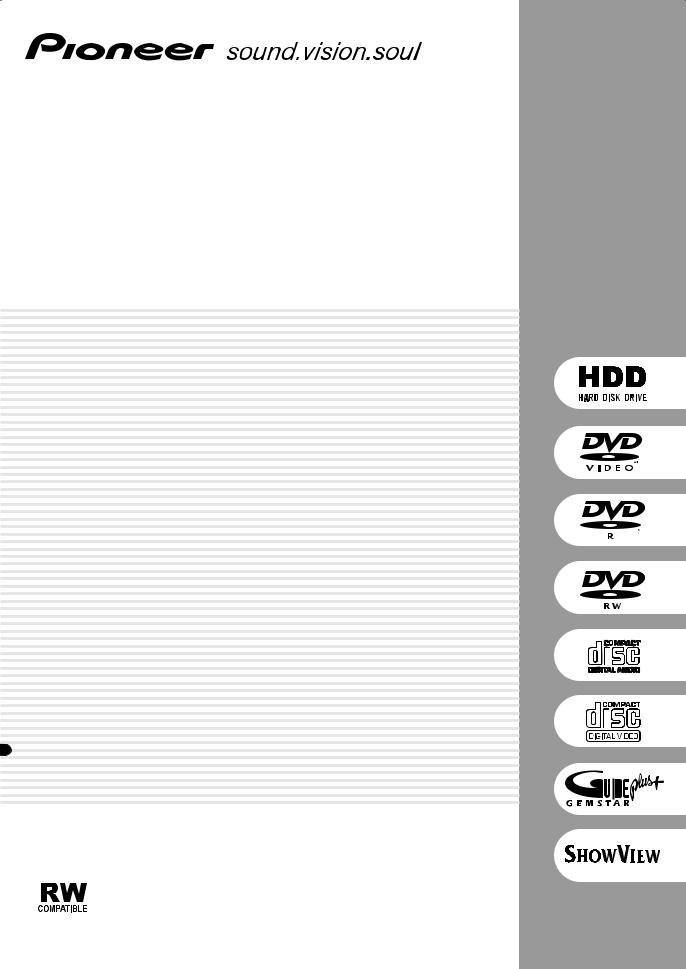
DVD Recorder
DVR-630H-S
DVR-530H-S
™
™
Operating Instructions
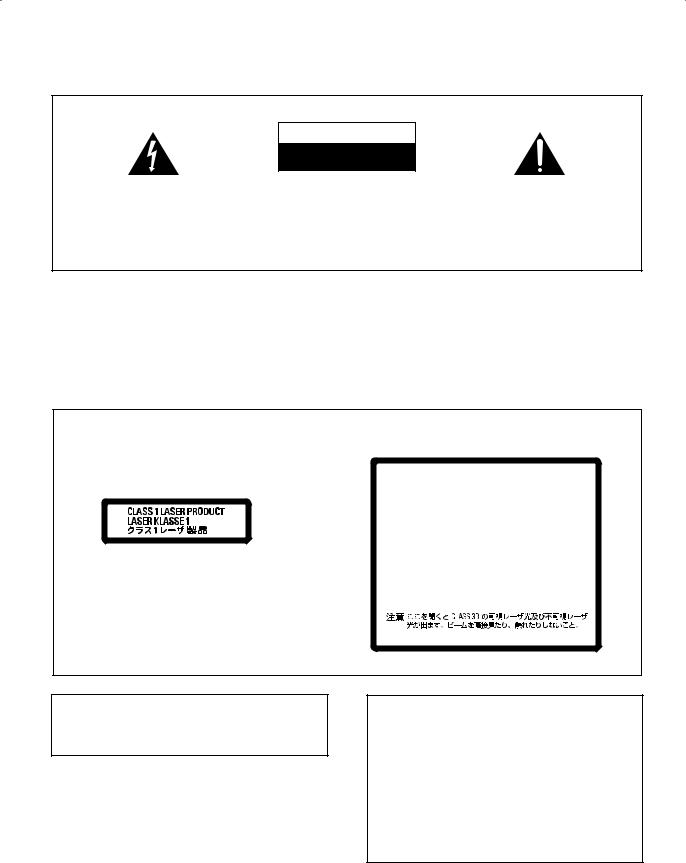
Thank you for buying this Pioneer product.
Please read through these operating instructions so you will know how to operate your model properly. After you have finished reading the instructions, put them away in a safe place for future reference.
IMPORTANT
CAUTION
RISK OF ELECTRIC SHOCK
DO NOT OPEN
The lightning flash with arrowhead symbol, within an equilateral triangle, is intended to alert the user to the presence of uninsulated "dangerous voltage" within the product's enclosure that may be of sufficient magnitude to constitute a risk of electric shock to persons.
CAUTION:
TO PREVENT THE RISK OF ELECTRIC SHOCK, DO NOT REMOVE COVER (OR BACK). NO USER-SERVICEABLE PARTS INSIDE. REFER SERVICING TO QUALIFIED SERVICE PERSONNEL.
The exclamation point within an equilateral triangle is intended to alert the user to the presence of important operating and maintenance (servicing) instructions in the literature accompanying the appliance.
D3-4-2-1-1_En-A
WARNING
This equipment is not waterproof. To prevent a fire or shock hazard, do not place any container filed with liquid near this equipment (such as a vase or flower pot) or expose it to dripping, splashing, rain or moisture.
WARNING
Before plugging in for the first time, read the following section carefully.
The voltage of the available power supply differs according to country or region. Be sure that the power supply voltage of the area where this unit will be used meets the required voltage (e.g., 230V or 120V) written on the rear panel.
CAUTION
This product is a class 1 laser product, but this product contains a laser diode higher than Class 1. To ensure continued safety, do not remove any covers or attempt to gain access to the inside of the product. Refer all servicing to qualified personnel.
The following caution label appears on your unit. Location: inside of the unit
CAUTION CLASS 3B VISIBLE AND INVISIBLE LASER RADIATION WHEN OPEN, AVOID EXPOSURE TO THE BEAM.
ATTENTION RADIATIONS LASER VISIBLES ET INVISIBLES DE CLASSE 3B QUAND OUVERT. ÉVITEZ TOUT EXPOSITION AU FAISCEAU.
ADVARSEL KLASSE 3B SYNLIG OG USYNLIG LASERSTRÅLING VED ÅBNING. UNDGÅ UDSÆTTELSE FOR STRÅLING.
VARNING KLASS 3B SYNLIG OCH OSYNLIG LASERSTRÅLNING NÄR DENNA DEL ÄR ÖPPNAD. UNDVIK ATT UTSÄTTA DIG FÖR STRÅLEN.
VORSICHT BEI GEÖFFNETER ABDECKUNG IST SICHTBARE UND UNSICHTBARE LASERSTRAHLUNG DER KLASSE 3B IM GERÄTEINNEREN VORHANDEN. AUGEN NICHT DEM LASERSTRAHLAUSSETZEN!
PRECAUCIAÓN CUANDO SE ABRE HAY RADIACIÓN LÁSER DE CLASE 3B VISIBLE E INVISIBLE. EVITE LA EXPOSICIÓN A LOS RAYOS LÁSER.
VARO! AVATTAESSA OLET ALTTIINA NÄKYVÄLLE JA NÄKYMÄTTÖMÄLLE LUOKAN 3B LASERSÄTEILYLLE. ÄLÄ KATSO SÄTEESEEN.
DRW2247 - A
D3-4-2-1-8_A_En
This product complies with the Low Voltage Directive (73/23/EEC, amended by 93/68/EEC), EMC Directives (89/336/EEC, amended by 92/31/EEC and 93/68/EEC).
CAUTION
The STANDBY/ON switch on this unit will not completely shut off all power from the AC outlet. Since the power cord serves as the main disconnect device for the unit, you will need to unplug it from the AC outlet to shut down all power. Therefore, make sure the unit has been installed so that the power cord can be easily unplugged from the AC outlet in case of an accident. To avoid fire hazard, the power cord should also be unplugged from the AC outlet when left unused for a long period of time (for example, when on vacation).

WARNING
To prevent a fire hazard, do not place any naked flame sources (such as a lighted candle) on the equipment.
Operating Environment
Operating environment temperature and humidity: +5 ºC – +35 ºC (+41 ºF – +95 ºF); less than 85 %RH (cooling vents not blocked)
Do not install this unit in a poorly ventilated area, or in locations exposed to high humidity or direct sunlight (or strong artificial light)
VENTILATION CAUTION
When installing this unit, make sure to leave space around the unit for ventilation to improve heat radiation (at least 10 cm at top, 10 cm at rear, and 10 cm at each side).
WARNING
Slots and openings in the cabinet are provided for ventilation to ensure reliable operation of the product, and to protect it from overheating. To prevent fire hazard, the openings should never be blocked or covered with items (such as newspapers, table-cloths, curtains) or by operating the equipment on thick carpet or a bed.
If the AC plug of this unit does not match the AC outlet you want to use, the plug must be removed and appropriate one fitted. Replacement and mounting of an AC plug on the power supply cord of this unit should be performed only by qualified service personnel. If connected to an AC outlet, the cut-off plug can cause severe electrical shock. Make sure it is properly disposed of after removal.
The equipment should be disconnected by removing the mains plug from the wall socket when not left unused for a long period of time (for example, when on vacation).
This product incorporates copyright protection technology that is protected by method claims of certain U.S. patents and other intellectual property rights owned by Macrovision Corporation and other rights owners. Use of this copyright protection technology must be authorized by Macrovision Corporation, and is intended for home and other limited viewing uses only unless otherwise authorized by Macrovision Corporation. Reverse engineering or disassembly is prohibited.
This product is for general household purposes. Any failure due to use for other than household purposes (such as longterm use for business purposes in a restaurant or use in a car or ship) and which requires repair will be charged for even during the warranty period.
This product includes FontAvenue®
corporation. FontAvenue is a registered trademark of NEC
Corporation.
POWER-CORD CAUTION
Handle the power cord by the plug. Do not pull out the plug by tugging the cord and never touch the power cord when your hands are wet as this could cause a short circuit or electric shock. Do not place the unit, a piece of furniture, etc., on the power cord, or pinch the cord. Never make a knot in the cord or tie it with other cords. The power cords should be routed such that they are not likely to be stepped on. A damaged power cord can cause a fire or give you an electrical shock. Check the power cord once in a while. When you find it damaged, ask your nearest PIONEER authorized service center or your dealer for a replacement.

Contents
01 Before you start
Features . . . . . . . . . . . . . . . . . . . . . . . . . . . . . . . . . . . 6 What’s in the box . . . . . . . . . . . . . . . . . . . . . . . . . . . . 8
Putting the batteries in the remote control . . . . . . . . . 8
Using the remote control . . . . . . . . . . . . . . . . . . . . . . 8
Disc / content format playback compatibility . . . . . . . 9 About the internal hard disk drive. . . . . . . . . . . . . . . 11
02 Connecting up
Rear panel connections . . . . . . . . . . . . . . . . . . . . . . 12 Front panel connections . . . . . . . . . . . . . . . . . . . . . . 12
Extra features for use with compatible TVs . . . . . . . . 13
Easy connections . . . . . . . . . . . . . . . . . . . . . . . . . . . 14
Using other types of audio/video output . . . . . . . . . . 15 Connecting to a cable box, satellite receiver or
digital terrestrial receiver . . . . . . . . . . . . . . . . . . . . . 16 Connecting an external decoder box (1) . . . . . . . . . . 17 Connecting an external decoder box (2) . . . . . . . . . . 18 Connecting to an AV amplifier/receiver . . . . . . . . . . 19 Connecting other AV sources . . . . . . . . . . . . . . . . . . 20
Plugging in . . . . . . . . . . . . . . . . . . . . . . . . . . . . . . . . 20
03 Controls and displays
Front panel . . . . . . . . . . . . . . . . . . . . . . . . . . . . . . . . 21 Remote control. . . . . . . . . . . . . . . . . . . . . . . . . . . . . 22 Display . . . . . . . . . . . . . . . . . . . . . . . . . . . . . . . . . . . 24
04 Getting started
Switching on and setting up . . . . . . . . . . . . . . . . . . . 25 Setting up the GUIDE Plus+™ system . . . . . . . . . . . 27 Selecting the hard disk or DVD for playback and recording . . . . . . . . . . . . . . . . . . . . . . . . . . . . . . . . . 30
Making your first recording. . . . . . . . . . . . . . . . . . . . 30 Using the built-in TV tuner . . . . . . . . . . . . . . . . . . . . 31
Basic playback . . . . . . . . . . . . . . . . . . . . . . . . . . . . . 32 Using the Home Menu . . . . . . . . . . . . . . . . . . . . . . . 35
Displaying disc information on-screen . . . . . . . . . . . 35
05 Using the GUIDE Plus+™ electronic program guide
The GUIDE Plus+™ system . . . . . . . . . . . . . . . . . . . 38
Using the GUIDE Plus+™ system . . . . . . . . . . . . . . 38
Areas . . . . . . . . . . . . . . . . . . . . . . . . . . . . . . . . . . . . 40
GUIDE Plus+™ FAQ and troubleshooting . . . . . . . . 47
4
06 Recording
About DVD recording . . . . . . . . . . . . . . . . . . . . . . . . 49 About HDD recording. . . . . . . . . . . . . . . . . . . . . . . . 49
Recording time and picture quality. . . . . . . . . . . . . . 50
Recorded audio . . . . . . . . . . . . . . . . . . . . . . . . . . . . 50
Restrictions on video recording . . . . . . . . . . . . . . . . 50 Setting the picture quality/recording time . . . . . . . . 51 Basic recording from the TV . . . . . . . . . . . . . . . . . . . 51
Setting a timer recording . . . . . . . . . . . . . . . . . . . . . 53 Timer recording FAQ . . . . . . . . . . . . . . . . . . . . . . . . 56
Simultaneous recording and playback . . . . . . . . . . . 56 Recording from an external component . . . . . . . . . . 57 Recording from a DV camcorder . . . . . . . . . . . . . . . 58 Playing your recordings on other DVD players . . . . . 59 Initializing a recordable DVD disc. . . . . . . . . . . . . . . 60
07 Playback
Introduction . . . . . . . . . . . . . . . . . . . . . . . . . . . . . . . 61
Navigating discs and the HDD . . . . . . . . . . . . . . . . . 61 Using the Disc Navigator to browse the contents
of a disc.. . . . . . . . . . . . . . . . . . . . . . . . . . . . . . . . . . 62 Scanning discs. . . . . . . . . . . . . . . . . . . . . . . . . . . . . 64 Playing in slow motion . . . . . . . . . . . . . . . . . . . . . . . 64
Frame advance/frame reverse . . . . . . . . . . . . . . . . . 65
The Play Mode menu . . . . . . . . . . . . . . . . . . . . . . . . 65
Displaying and switching subtitles . . . . . . . . . . . . . . 68 Switching DVD soundtracks . . . . . . . . . . . . . . . . . . . 69 Switching audio channels . . . . . . . . . . . . . . . . . . . . 69
Switching camera angles . . . . . . . . . . . . . . . . . . . . . 70
08 Copying and back-up
Introduction . . . . . . . . . . . . . . . . . . . . . . . . . . . . . . . 71 One Touch Copy . . . . . . . . . . . . . . . . . . . . . . . . . . . . 71 Using Copy Lists. . . . . . . . . . . . . . . . . . . . . . . . . . . . 72 Using disc back-up. . . . . . . . . . . . . . . . . . . . . . . . . . 79
09 Editing
The Disc Navigator screen . . . . . . . . . . . . . . . . . . . . 81 Command menu panel options . . . . . . . . . . . . . . . . 82
Editing accuracy. . . . . . . . . . . . . . . . . . . . . . . . . . . . 82 HDD genres . . . . . . . . . . . . . . . . . . . . . . . . . . . . . . . 82
10 Using the Jukebox
Copying CDs to the HDD . . . . . . . . . . . . . . . . . . . . . 90
Playing music from the Jukebox . . . . . . . . . . . . . . . . 91
Editing Jukebox albums . . . . . . . . . . . . . . . . . . . . . . 91
En

11 The PhotoViewer
Playing a slideshow . . . . . . . . . . . . . . . . . . . . . . . . . 93
12 The Disc Setup menu
Introduction. . . . . . . . . . . . . . . . . . . . . . . . . . . . . . . 95 Basic settings . . . . . . . . . . . . . . . . . . . . . . . . . . . . . 95 Initialize settings . . . . . . . . . . . . . . . . . . . . . . . . . . . 95 Finalize settings . . . . . . . . . . . . . . . . . . . . . . . . . . . . 96 Optimize HDD . . . . . . . . . . . . . . . . . . . . . . . . . . . . . 96 Initialize HDD . . . . . . . . . . . . . . . . . . . . . . . . . . . . . 96
13 The Video/Audio Adjust menu
Setting the picture quality for TV and external
inputs . . . . . . . . . . . . . . . . . . . . . . . . . . . . . . . . . . . 97
Setting the picture quality for disc playback . . . . . . 98
Audio DRC. . . . . . . . . . . . . . . . . . . . . . . . . . . . . . . . 99
14 The Initial Setup menu
Using the Initial Setup menu . . . . . . . . . . . . . . . . . 100
15 Additional information
Resetting the recorder . . . . . . . . . . . . . . . . . . . . . . 109
Setting up the remote to control your TV . . . . . . . . 109 Screen sizes and disc formats . . . . . . . . . . . . . . . . 110
Minimum copying times . . . . . . . . . . . . . . . . . . . . 111 Troubleshooting. . . . . . . . . . . . . . . . . . . . . . . . . . . 112
Frequently asked questions . . . . . . . . . . . . . . . . . . 114
About DV . . . . . . . . . . . . . . . . . . . . . . . . . . . . . . . . 115 Manual recording modes. . . . . . . . . . . . . . . . . . . . 116 Language code list. . . . . . . . . . . . . . . . . . . . . . . . . 117 Country/Area code list . . . . . . . . . . . . . . . . . . . . . . 117
On-screen displays and recorder displays . . . . . . . 118
Handling discs. . . . . . . . . . . . . . . . . . . . . . . . . . . . 119 Cleaning the pickup lens . . . . . . . . . . . . . . . . . . . . 120 Condensation . . . . . . . . . . . . . . . . . . . . . . . . . . . . 120 Hints on installation. . . . . . . . . . . . . . . . . . . . . . . . 120 Glossary. . . . . . . . . . . . . . . . . . . . . . . . . . . . . . . . . 121 Specifications . . . . . . . . . . . . . . . . . . . . . . . . . . . . 123
Index
5
En

01 Before you start
Chapter 1
Before you start
Features
• Built-in GUIDE Plus+™ electronic program guide
The GUIDE Plus+™ system is an interactive on-screen TV programming guide. You can see what’s on TV today and in the coming week, search TV listings for certain categories of program or by your own keywords, and even set the recorder to record programs with the press of a single button.
• HDD recording HDD
Record up to 711 hours of video (in MN1 mode) on the DVR-630H-S’s internal 250 GB (gigabyte) hard disk (HDD). (Up to 455 hours on the DVR-530H-S’s 160 GB HDD.)
With both recordable DVD and a high-capacity HDD in the same recorder, you have the flexibility to keep recordings on the HDD for quick access anytime, or record to DVD for archiving or playing on other DVD players.
•Copy between HDD and DVD
You can quickly and easily copy recordings between the HDD and DVD. When copying to DVD you can usually use the high-speed copy feature, which can copy an hour of video in about one minute (when recorded in SEP mode using a DVD-R Ver. 2.0 / 2.1 (16x) disc).
You can also choose to copy material at a different recording quality from the original. For example, you might want to copy an XP mode (highest quality) recording on the HDD to SP (standard play) quality on a DVD so that you can fit other recordings on the same disc.
•One Touch Copy
One Touch Copy makes copying the currently playing title from HDD to DVD, or DVD to HDD as simple as pressing a button.
•High quality, real-time copying
When recording to the HDD, picture quality data is also stored so that picture quality can be optimized when making real-time copies to DVD later.
(This is applicable only to MN16–32 HDD recordings (Video Mode Off), or MN12–32 / XP+ recordings (Video Mode On).
6
• Chase play VR mode |
HDD |
Using chase play you can start watching a recording from the beginning, while continuing to record. For example, you could set a timer recording for a program that you’re going to miss the first 15 minutes of, then start watching while the recorder is still recording the program 15 minutes ahead of you.
•Simultaneous recording and playback
VR mode |
HDD |
HDD and DVD playback and recording are completely independent. For example, you can record a broadcast program to a recordable DVD, while watching another recording you already made on the same DVD.
•On-screen Help
Use the HELP button on the remote control to display a help screen for the current operation.
•Disc Navigator
The on-screen Disc Navigator makes finding your way around the contents of a disc or the HDD easy. For recordable DVD and HDD content, moving thumbnail images are displayed for ease of use. The Disc Navigator is also where you can edit HDD and recordable DVD content.
•Home Menu
The Home Menu gives you on-screen access to all the recorder’s features in one convenient place, from setting up the recorder, to programming a timer recording and editing a recording.
•Progressive scan-compatible
Compared to standard interlaced video, progressive scan effectively doubles the amount of video information fed to your TV or monitor. The result is a stable, flicker-free image. (Check your TV/monitor for compatibility with this feature.)
•Cinema-style surround sound in your home
Connect this recorder to a Dolby Digital and/or DTScompatible AV amp/receiver to enjoy full surround sound effects from Dolby Digital and DTS DVD discs.
•Easy Timer Recording
Setting the recorder to record a program is simple from the Easy Timer Recording screen. Set the channel to record and the recording quality, then graphically set the start and end times of the recording. That’s it!
En
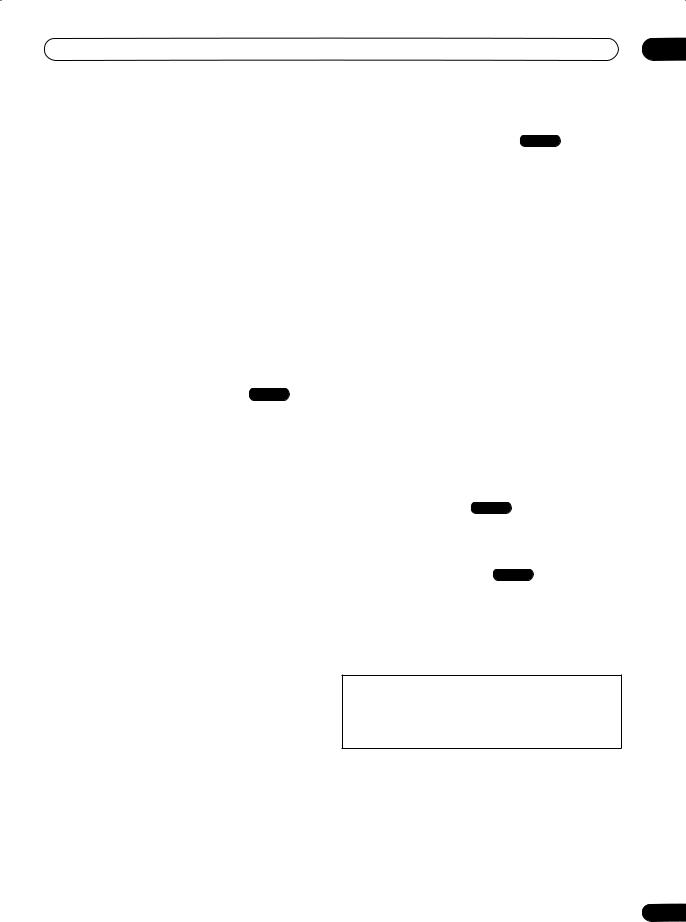
Before you start |
01 |
•Program up to 32 timer recordings
You can program the recorder to record up to 32 programs, up to a month in advance. As well as single programs, you can specify daily or weekly recordings, too.
This recorder is also compatible with VPS/PDC systems, which ensure you don’t miss a timer recording, even if the broadcast is not running to schedule.
•One Touch Recording
Use One Touch Recording to start recording immediately in 30 minute blocks. Each time you press the REC button, the recording time is extended by another 30 minutes, up to six hours.
•Optimized recording
Optimized recording adjusts the recording quality automatically if a timer recording will not fit onto a disc with the settings that you made.
• Super high quality HDD recording HDD
Using the XP+ recording mode you can record super high quality video (around 15 Mbps data transfer rate) to the HDD.
•High quality 16-bit Linear PCM audio
In the LPCM recording mode, audio is recorded in uncompressed 16-bit Linear PCM format. This delivers great sounding audio to accompany the high picture quality.
•Picture quality adjustment features
During playback, you can adjust various picture quality settings to improve the picture. You can also adjust the recording picture quality. For example, if you want to make a DVD copy of an old video tape, you can optimize the picture quality before transferring it to disc.
•Find what you want to watch quickly and easily
Unlike video tape that needs to be wound to the correct place, you can jump right to the part of a DVD disc or the HDD that you want to watch. Search for a point on a disc by title, chapter or time.
•Manual recording
In addition to six preset recording quality modes, the manual recording mode allows you to access 34 different recording quality/time settings, giving you precise control over the recording.
•Record from a DV camcorder
This recorder has a built-in DV (Digital Video) input for connection to a DV camcorder. This makes it ideal for transferring camcorder footage to DVD or HDD for editing.
• Safe, non-destructive editing
When editing Play List content, the actual content of the disc (the Original content) is not touched. The edited version (the Play List content) just points to various parts of the Original content.
•Play Video mode recordings on a regular DVD
player 
Discs recorded using the Video mode can be played back on regular DVD players, including computer DVD drives
compatible with DVD-Video playback*.
* ‘DVD-Video format’ recording: The use of the DVD-Video format for recording on DVD-R and DVD-RW discs is referred to as recording in ‘Video mode’ on Pioneer’s DVD recorders. Supporting playback of DVD- R / DVD-RW discs is optional for manufacturers of DVD playback equipment, and there is DVD playback equipment that does not play DVD-R or DVD-RW discs recorded in the DVD-Video format.
Note: ‘Finalization’ is required.
•WMA, MP3 and JPEG file playback
This recorder can play WMA and MP3 audio files and JPEG picture files on CD-R, CD-RW or CD-ROM discs.
•Disc Back-up
The disc back-up feature gives you a convenient way to back-up important material on a finalized Video mode DVD to another recordable DVD disc. The material is first copied to the HDD, then on to a second DVD disc.
• Recovery Recording HDD
When a timer recording is set to use DVD but the disc loaded at the time of the recording is unrecordable, the program will automatically be recorded to the HDD.
• Auto Replace Recording HDD
This feature is useful for regular timer recordings of a TV program which you don’t want to keep after watching. Each time the program is recorded, it replaces the one currently on the HDD. There’s no need to manually delete it later.
Note on copying:
Recording equipment should be used only for lawful copying and you are advised to check carefully what is lawful copying in the country in which you are making a copy. Copying of copyright material such as films or music is unlawful unless permitted by a legal exception or consented to by the rightowners.
7
En
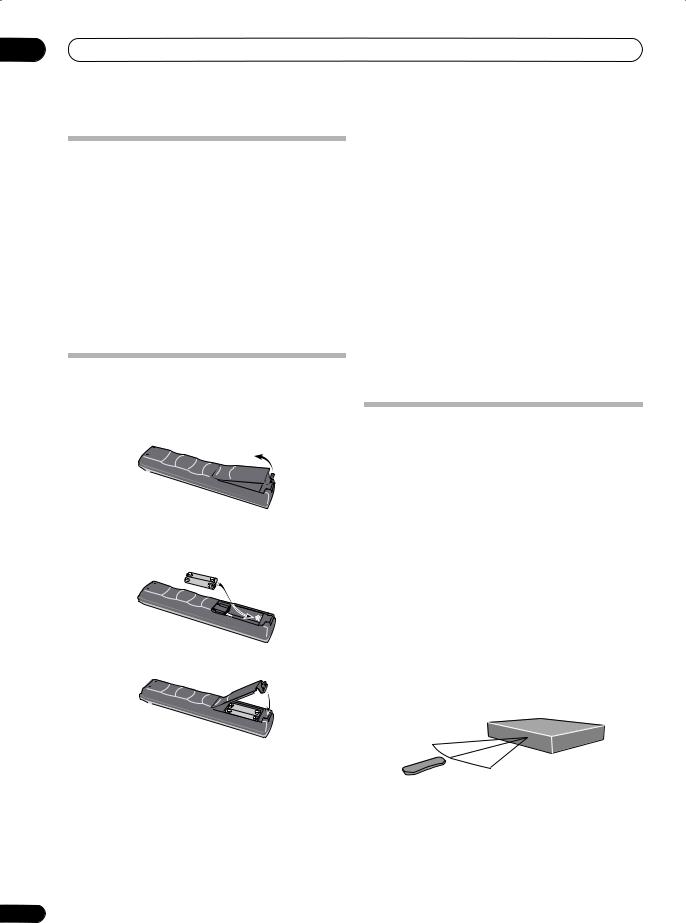
01 Before you start
What’s in the box
Please confirm that the following accessories are in the box when you open it.
•Remote control
•AA/R6P dry cell batteries x2
•Audio/video cable (red/white/yellow)
•G-LINK™ cable
•RF antenna cable
•Power cable
•These operating instructions
•Warranty card
Putting the batteries in the remote control
1 Open the battery compartment cover on the back of the remote control.
2 Insert two AA/R6P batteries into the battery compartment following the indications ( , ) inside the compartment.
3 Close the cover.
8
 Important
Important
Incorrect use of batteries can result in hazards such as leakage and bursting. Please observe the following:
•Don’t mix new and old batteries together.
•Don’t use different kinds of batteries together— although they may look similar, different batteries may have different voltages.
•Make sure that the plus and minus ends of each battery match the indications in the battery compartment.
•Remove batteries from equipment that isn’t going to be used for a month or more.
•When disposing of used batteries, please comply with governmental regulations or environmental public instruction’s rules that apply in your country or area.
Using the remote control
Please keep in mind the following when using the remote control:
•Make sure that there are no obstacles between the remote and the remote sensor on the unit.
•Remote operation may become unreliable if strong sunlight or fluorescent light is shining on the unit’s remote sensor.
•Remote controllers for different devices can interfere with each other. Avoid using remotes for other equipment located close to this unit.
•Replace the batteries when you notice a fall off in the operating range of the remote.
•When the batteries run down or you change the batteries, the remote control mode and TV preset codes are automatically reset. See Remote Control Mode on page 106 and Setting up the remote to control your TV on page 109 to reset them.
•Use within the operating range in front of the remote control sensor on the front panel, as shown.
 7 m
7 m
•You can control this recorder using the remote sensor of another Pioneer component using the CONTROL IN jack on the rear panel. See Rear panel connections on page 12 for more information.
En
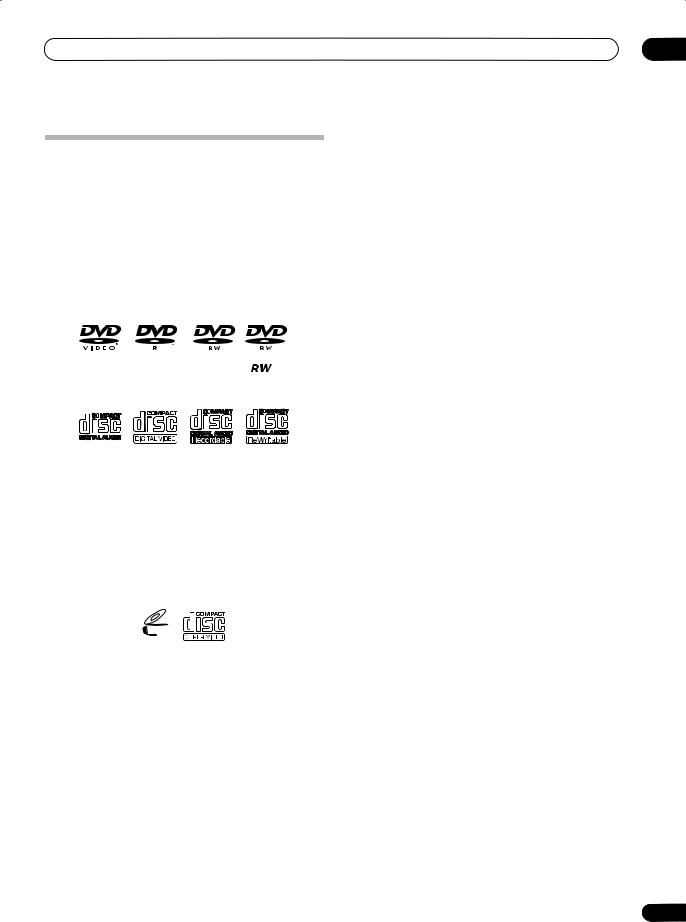
Before you start |
01 |
Disc / content format playback compatibility
General disc compatibility
This recorder is compatible with a wide range of disc types (media) and formats. Playable discs will generally feature one of the following logos on the disc and/or disc packaging. Note however that some disc types, such as recordable CD and DVD, may be in an unplayable format—see below for further compatibility information.
DVD-Video |
DVD-R |
DVD-RW |
|
|
|
|
|
|
|
|
|
|
|
|
Note that older models of DVD recorders and DVD writers may reject DVD-RW Ver. 1.2 discs and/or corrupt the data on the disc. If you want to share DVD-RW discs between this recorder and an older recorder/writer, we recommend using Ver. 1.1 discs.
The following table shows older Pioneer DVD recorders’ limited compatibility with DVD-RW Ver. 1.2 discs.
Model |
Playable |
Recordable |
DVR-7000 |
Yes1,2,3 |
No |
DVR-3100/ DVR-5100H |
Yes1 |
No |
1Discs should be finalized in this recorder before playing. Unfinalized VR mode and Video mode discs may not play.
2Cannot read the CPRM information will show in the display when you load a disc. However, this will not affect playback.
3Copy-once protected disc titles will not play.
Audio CD |
Video CD |
CD-R |
CD-RW |
•Also compatible with KODAK Picture CD
• is a trademark of DVD Format/Logo Licensing Corporation.
is a trademark of DVD Format/Logo Licensing Corporation.
• is a trademark of Fuji Photo Film Co. Ltd.
is a trademark of Fuji Photo Film Co. Ltd.
This recorder also supports the IEC’s Super VCD standard. Compared to the Video CD standard, Super VCD offers superior picture quality, and allows two soundtracks to be recorded. Super VCD also supports the widescreen size.
VIDEO

 CD
CD
Super Video CD (Super VCD)
DVD-R/RW compatibility
This recorder will play and record DVD-R/RW discs.
Compatible media:
•DVD-RW Ver. 1.1, Ver. 1.1 / 2x, Ver. 1.2 / 2–4x and Ver. 1.2 / 2–6x
•DVD-R Ver. 2.0 and Ver. 2.0 / 4x / 8x / 16x, and Ver. 2.1 1–8x / 1–16x
Recording formats:
•DVD-R/RW: Video Recording (VR) format and DVDVideo format (Video mode)
Readable formats:
•DVD-R/RW: Video Recording (VR) format and DVDVideo format (Video mode)
CD-R/RW compatibility
This recorder cannot record CD-R or CD-RW discs.
•Readable formats: CD-Audio, Video CD/Super VCD, ISO 9660 CD-ROM* containing MP3, WMA or JPEG files
*ISO 9660 Level 1 or 2 compliant. CD physical format: Mode1, Mode2 XA Form1. Romeo and Joliet file systems are both compatible with this recorder.
•Multi-session playback: Yes (except CD-Audio and Video CD/Super VCD)
•Unfinalized disc playback: CD-Audio only
Compressed audio compatibility
•Compatible media: CD-ROM, CD-R, CD-RW
•Compatible formats: MPEG-1 Audio Layer 3 (MP3), Windows Media Audio (WMA)
•Sampling rates: 44.1 or 48kHz
•Bit-rates: Any (128Kbps or higher recommended)
•Variable bit-rate (VBR) MP3 playback: Yes
•VBR WMA playback: No
•WMA encoder compatibility: Windows Media Codec 8 (files encoded using Windows Media Codec 9 may be playable but some parts of the specification are not supported; specifically, Pro, Lossless, Voice and VBR)
•DRM (Digital Rights Management) file playback: No (see also DRM in the Glossary on page 121)
•File extensions: .mp3, .wma (these must be used for the recorder to recognize MP3 and WMA files – do not use for other file types)
•File structure: Up to 99 folders / 999 files (if these limits are exceeded, only files and folders up to these limits are playable)
9
En

01 Before you start
WMA (Windows Media Audio) compatibility
The Windows Media® logo printed on the box indicates that this recorder can playback Windows Media Audio content.
WMA is an acronym for Windows Media Audio and refers to an audio compression technology developed by Microsoft Corporation. WMA content can be encoded by
using Windows Media® Player for Windows® XP,
Windows Media® Player 9 or Windows Media® Player 10 series.
Microsoft, Windows Media, and the Windows logo are trademarks, or registered trademarks of Microsoft Corporation in the United States and/or other countries.
JPEG file compatibility
•Compatible formats: Baseline JPEG and EXIF 2.2* still image files
*File format used by digital still cameras
•Sampling ratio: 4:4:4, 4:2:2, 4:2:0
•Horizontal resolution: 160 – 5120 pixels
•Vertical resolution: 120 – 3840 pixels
•Progressive JPEG compatible: No
•File extensions: .jpg, .jpeg, .jif, .jfif (must be used for the recorder to recognize JPEG files – do not use for other file types)
•File structure: The recorder can load up to 99 folders / 999 files at one time (if there are more files/folders that this on the disc then more can be reloaded)
PC-created disc compatibility
Discs recorded using a personal computer may not be playable in this unit due to the setting of the application software used to create the disc. In these particular instances, check with the software publisher for more detailed information.
Discs recorded in packet write mode (UDF format) are not compatible with this recorder.
Check the DVD-R/RW or CD-R/RW software disc boxes for additional compatibility information.
10
 Frequently asked questions
Frequently asked questions
•What’s the difference between DVD-R and DVD-RW?
The most important difference between DVD-R and DVD-RW is that DVD-R is a record-once medium, while DVD-RW is a re-recordable/erasable medium. You can re-record/erase a DVD-RW disc approximately 1,000 times.
For more information, see About DVD recording on page 49.
•What’s VR mode?
VR (Video Recording) mode is a special mode designed for home DVD recording. It allows flexible editing of recorded material compared to ‘Video mode’. On the other hand, Video mode discs are more compatible with other DVD players.
•How do I change the format of a disc?
Both DVD-R and DVD-RW discs can be initialized for Video mode or VR mode recording. DVD-R discs are ready for Video mode recording when you first load them into the recorder. You can, however, initialize them for VR mode recording from the Disc Setup menu.
DVD-RW discs can be initialized and re-initialized for either mode at any time (although initializing will erase all the data on the disc).
•Can I play my recordable discs in a regular DVD player?
Generally, DVD-R discs and DVD-RW discs recorded in Video mode* are playable in a standard DVD player, but they must be ‘finalized’ first. This process fixes the contents of the disc to make them readable to other DVD players as DVD-Video discs.
DVD-R discs recorded in VR mode are not playable in standard DVD players, but may be playable in other DVD recorders and DVD-ROM drives (in the case of DVD-ROM drives, the disc will need to be finalized first).
DVD-RW discs recorded in VR mode are playable in some players and other recorders.
Note that discs may not play due to recording or disc characteristics, scratches or dirt on the disc or pickup lens, etc.


 This label indicates playback compatibility with DVD-RW discs recorded in VR mode (Video Recording format). However, for discs recorded with a record-only-once encrypted program, playback can only be achieved using a CPRM compatible device.
This label indicates playback compatibility with DVD-RW discs recorded in VR mode (Video Recording format). However, for discs recorded with a record-only-once encrypted program, playback can only be achieved using a CPRM compatible device.
Note that Pioneer cannot guarantee that discs recorded using this recorder will play on other players.
En
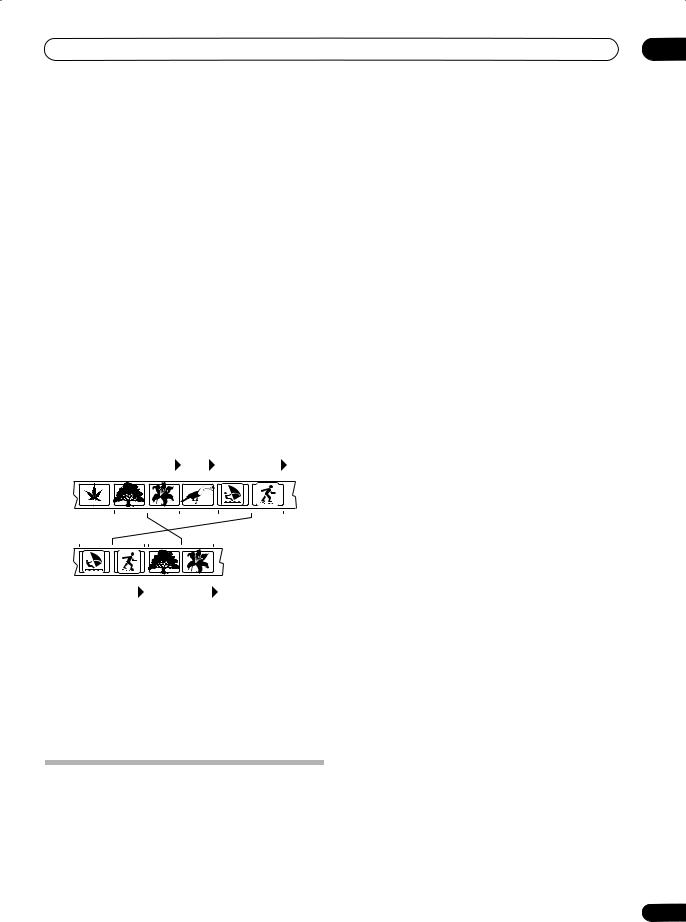
Before you start |
01 |
* ‘DVD-Video format’ recording: The use of the DVDVideo format for recording on DVD-R and DVD-RW discs is referred to as recording in ‘Video mode’ on Pioneer’s DVD recorders. Supporting playback of DVD-R / DVDRW discs is optional for manufacturers of DVD playback equipment, and there is DVD playback equipment that does not play DVD-R or DVD-RW discs recorded in the DVD-Video format.
Note: ‘Finalization’ is required.
This recorder supports the recording of ‘copy-once’ broadcast programs using the CPRM copy protection system (see CPRM on page 50) on CPRM-compliant discs in VR mode. CPRM recordings can only be played on players that are specifically compatible with CPRM.
•Do I need two DVD recorders for editing? What kind of editing can I do?
Unlike editing video tape, you only need one DVD recorder to edit discs. With VR mode discs, you can edit by making a ‘Play List’ of what to play and when to play it. On playback, the recorder plays the disc according to the Play List.
Original
Title 1 |
|
|
|
|
|
|
Title 2 |
|
Title 3 |
|
|
|
|||
|
|
|
|
|
|
|
|
|
|
|
|
|
|
|
|
|
|
|
|
|
|
|
|
|
|
|
|
|
|
|
|
Chapter 1 |
Chapter 2 |
Chapter 3 |
|
|
Chapter 1 |
|
|
Chapter 1 |
Chapter 2 |
|
|||||
|
|
|
|
|
|
|
|
|
|
|
|
|
|
|
|
|
|
|
|
|
|
|
|
|
|
|
|
|
|
|
|
Title 1 |
|
|
Title 2 |
|
|
|
||
|
|
|
|
|
|
|
|
|
Chapter 1 |
Chapter 2 |
|
Chapter 1 |
Chapter 2 |
||||
Play List
Throughout this manual, you will often see the words Original and Play List to refer to the actual content and the edited version.
•Original content refers to what’s actually recorded on the disc.
•Play List content refers to the edited version of the disc—how the Original content is to be played.
Please use the recorder following the guidelines below to protect against possible HDD failure.
The HDD should not be regarded as a place to store recordings permanently. We recommend that you back up your important recordings onto DVD-R/RW discs in order to protect against accidental loss.
Pioneer cannot under any circumstances accept resposibility for any direct or indirect loss arising from any inconvenience or loss of recorded material resulting from HDD failure.
•Do not move the recorder while it is on (this includes during EPG download when the display shows EPG).
•Install and use the recorder on a stable, level surface.
•Do not block the rear vent/cooling fan.
•Do not use the recorder in excessively hot or humid places, or in places that may be subject to sudden changes in temperature. Sudden changes in temperature can cause condensation to form inside the recorder. This can be a cause of HDD failure.
•While the recorder is switched on (including during EPG download when the display shows EPG), do not unplug from the wall socket or switch the electricity off from the breaker switch.
•Do not move the recorder immediately after switching it off. If you need to move the recorder, please follow the steps below:
1 After the message POWER OFF is shown in the display, wait at least two minutes.
2 Unplug from the wall socket.
3 Move the recorder.
•If there’s a power failure while the recorder is on there is a chance that some data on the HDD will be lost.
•The HDD is very delicate. If used improperly or in an unsuitable environment, it is possible that the HDD will fail after a few years of use. Signs of problems include playback unexpectedly freezing and noticeable block noise (mosaic) in the picture. However, sometimes there will be no warning signs of HDD failure. If the HDD fails, no playback of recorded material will be possible. In this case it will be necessary to replace the HDD unit.
About the internal hard disk drive
The internal hard disk drive (HDD) is a fragile piece of equipment. Depending on the conditions under which it is used, or through careless use, it is possible that the recorded contents will be damaged or lost completely, or that normal playback and recording will not be possible. Please understand that in the event of repair or replacement of the HDD or related components, all your HDD recordings will be lost.
Optimizing HDD performance
As you record and edit material on the HDD, the data on the disk becomes fragmented, eventually affecting the recorder’s performance. Before this happens, the recorder will warn you that it is time to optimize the HDD (which you can do from the Disc Setup menu; see
Optimize HDD on page 96).
11
En
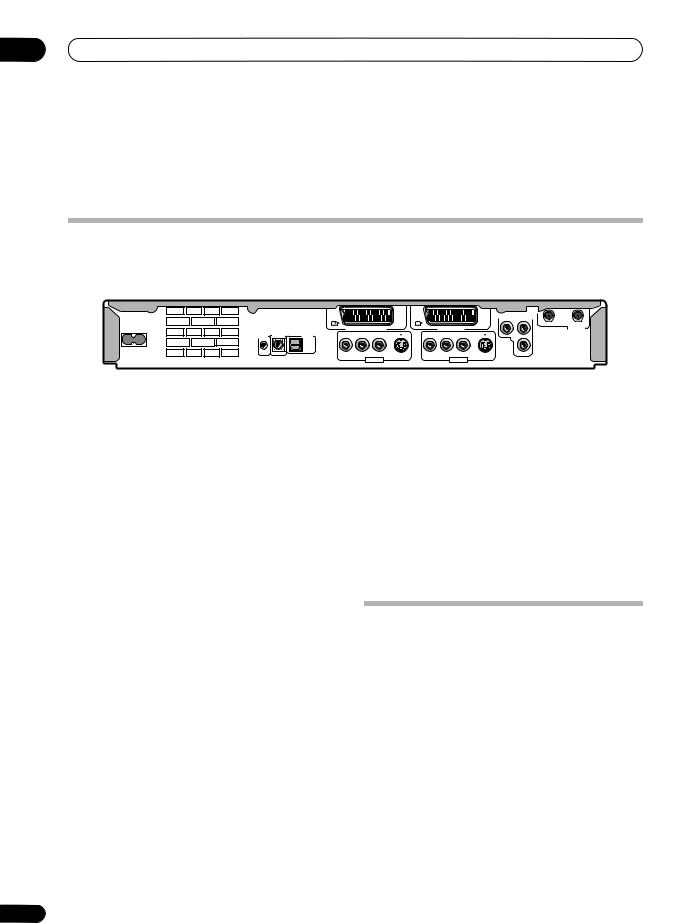
02 Connecting up
Chapter 2
Connecting up
Rear panel connections
1 |
2 |
3 |
|
4 |
|
COMPONENT VIDEO OUT |
|
|
|
AC IN |
Y |
PB |
IN |
OUT |
AV 1 (RGB) – TV |
|
|||
AV 2 (INPUT 1/DECODER) |
|
|
ANTENNA |
|
G-LINK |
CONTROL |
DIGITAL |
R |
L |
|
R |
L |
|
|
|
OUT |
|
|
|
|
|
|
|
|
OPTICAL |
|
|
|
|
|
|
|
IN |
|
AUDIO |
VIDEO |
S-VIDEO |
AUDIO |
VIDEO |
PR |
|
|
S-VIDEO |
||||||
|
|
|
|
INPUT 3 |
|
OUTPUT |
||
|
|
|
|
|
|
|
5 |
6 |
7 |
8 |
9 |
10 |
1AV2(INPUT 1/DECODER) AV connector
Audio/video input/output SCART-type AV connector for connecting to a VCR, or other equipment with a SCART connector. The input accepts video, S-video and RGB.
See AV2/L1 In on page 102 for how to set this up.
2AV1(RGB)-TV AV connector
Audio/video output SCART-type AV connector for connecting to a TV or other equipment with a SCART connector. The video output is switchable between video, S-video and RGB. See page AV1 Out on page 102 for how to set this up.
3 COMPONENT VIDEO OUT
A high-quality video output for connecting to a TV or monitor with a component video input.
4 ANTENNA IN (RF IN)/OUT
Connect your TV antenna to the ANTENNA IN (RF IN) jack. The signal is passed through to the ANTENNA OUT jack for connection to your TV.
5AC IN – Power inlet
6G-LINK™
Use to connect the supplied G-LINK™ cable to enable GUIDE Plus+™ to control an external satellite receiver, etc.
7 CONTROL IN
Use to control this recorder from the remote sensor of another Pioneer component with a CONTROL OUT terminal and bearing the Pioneer mark. Connect the CONTROL OUT of the other component to the CONTROL IN of this recorder using a mini-plug cord.
8 DIGITAL AUDIO OUT
Optical digital audio jack for connecting to an AV amplifier/receiver, Dolby Digital/DTS/MPEG decoder or other equipment with a digital input.
9 INPUT 3
Stereo analog audio, video and S-video inputs for connection to a VCR or other source component.
10 OUTPUT
Stereo analog audio, video and S-video outputs for connection to a TV or AV amplifier/receiver.
Front panel connections
DV IN |
S-VIDEO VIDEO L(MONO) |
R |
|
AUDIO |
|
|
INPUT 2 |
|
11 12
On the right side of the front panel a flip-down cover hides more connections.
11 DV IN
A DV input i.LINK connector, suitable for connecting a DV camcorder.
12 Audio/video input 2
Audio/video input (stereo analog audio; composite and S-video video), especially suitable for camcorders, game consoles, portable audio, etc.
12
En

Connecting up |
02 |
Extra features for use with compatible TVs
When this recorder is connected to a TV that features i/o Link. A, AV Link, T-V Link, EasyLink, MegaLogic, SMARTLINK, Q-Link, DATA LOGIC or NexTView Link using a fully-wired 21-pin SCART cable (not supplied), the following functions are available:
•Direct TV recording
•Channel preset download
•NexTView timer programming download
•TV auto power on
•System configuration
Note that these functions cannot be used when the front panel display shows EPG.
For further details and compatibility information, see also the manual that came with your TV.
Direct TV recording
Direct TV recording allows you to record the TV program that you’re watching, without having to worry about whether this recorder is set to the same channel. See
Direct recording from TV on page 52 for more on this feature.
Channel preset download
This feature allows you to set up the channel presets of this recorder very simply using the channel presets and preset names already in your TV. See Switching on and setting up on page 25 and Auto Channel Setting on page 101 for more on this feature.
NexTView timer programming download
NexTView timer programming download allows you to program a timer recording directly from the NexTView electronic program guide displayed on your TV.
See the manual that came with your TV for more information on how to use this feature. Note that the SP and LP options displayed on your TV correspond to the SP and LP recording modes on this recorder.
TV auto power on
When you play a disc in this recorder, the TV automatically turns on and switches to the correct video input. See the manual that came with your TV for how to use this feature.
System configuration
Basic settings, including language, country and TV screen size (aspect ratio), can be downloaded from your TV to help set up this recorder for use.
13
En
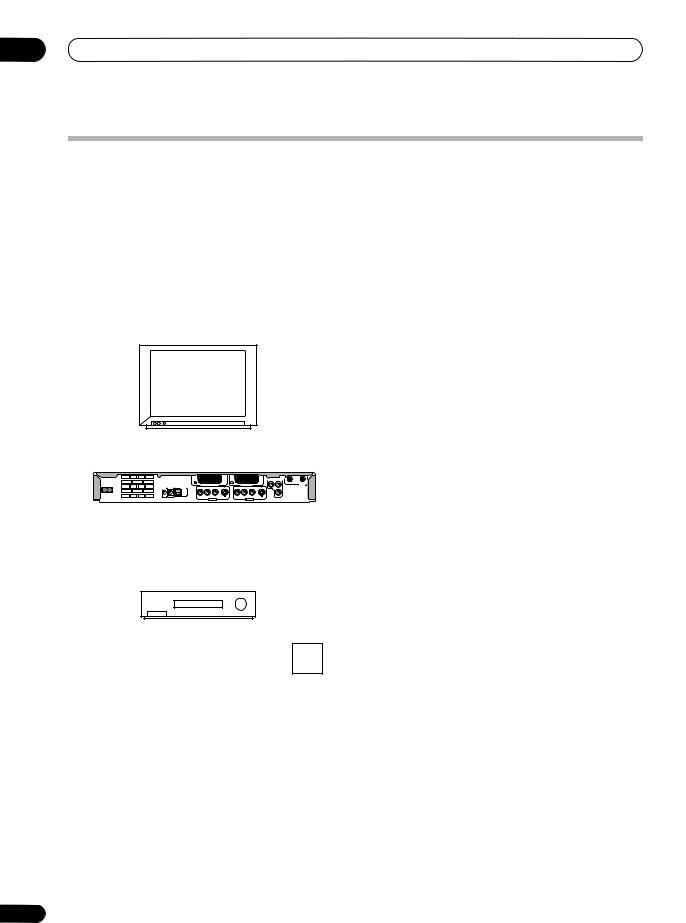
02 Connecting up
Easy connections
The setup described below is a basic setup that allows you to watch and record TV programs, and play discs. Other types of connections are explained starting on the following page.
 Important
Important
•These connections use SCART cables (not supplied). If your TV (or VCR) does not have a SCART connection, see the following page for connecting up using the supplied audio/video cable.
•The AV1(RGB)-TV AV connector can output ordinary (composite), S-video or RGB video, plus stereo analog audio. The AV2(INPUT 1/DECODER) connector accepts ordinary, S-video and RGB video input, as well as stereo analog audio. See AV1 Out on page 102 and AV2/L1 In on page 102 for how to set them up.
•Before making or changing any rear panel connections, make sure that all components are switched off and unplugged from the wall outlet.
SCART AV |
ANTENNA |
CONNECTOR |
IN |
|
3 |
TV |
|
4 |
ANTENNA |
|
OUT |
|
COMPONENT VIDEO OUT |
|
|
|
AC IN |
Y |
PB |
IN |
OUT |
AV 2 (INPUT 1/DECODER) |
AV 1 (RGB) – TV |
|
|
ANTENNA |
G-LINK |
CONTROL |
DIGITAL |
R |
L |
|
R |
L |
|
|
|
OUT |
|
|
|
|
|
|
|
|
OPTICAL |
|
|
|
|
|
|
|
IN |
|
AUDIO |
VIDEO |
S-VIDEO |
AUDIO |
VIDEO |
PR |
|
|
S-VIDEO |
||||||
|
|
|
|
INPUT 3 |
|
|
OUTPUT |
|
ANTENNA IN (RF IN)
5
2
SCART AV
CONNECTOR
ANTENNA
OUT
VCR |
ANTENNA |
|
|
|
IN |
1
Antenna/cable TV wall outlet
1Connect the cable from the antenna/cable TV outlet to the antenna input on your VCR.
•If you are not connecting a VCR in the chain, connect it to the ANTENNA IN (RF IN) jack on this recorder and skip the next step.
2Use an RF antenna cable (one is supplied) to connect the antenna output of your VCR to the ANTENNA IN (RF IN) of this recorder.
3Use another RF antenna cable to connect the ANTENNA OUT of this recorder to the antenna input on your TV.
4Use a SCART cable (not supplied) to connect the AV1(RGB)-TV AV connector on this recorder to the SCART AV connector on your TV.
5Use another SCART cable to connect the AV2(INPUT 1/DECODER) AV connector to a SCART AV connector on your VCR.
 Tip
Tip
•This recorder has a ‘through’ function which allows you to record a TV program from the built-in TV tuner in this recorder while watching a video playing on your VCR. (To use this feature when the recorder is in standby, Power Save must be set to Off—see Power Save on page 100).
14
En
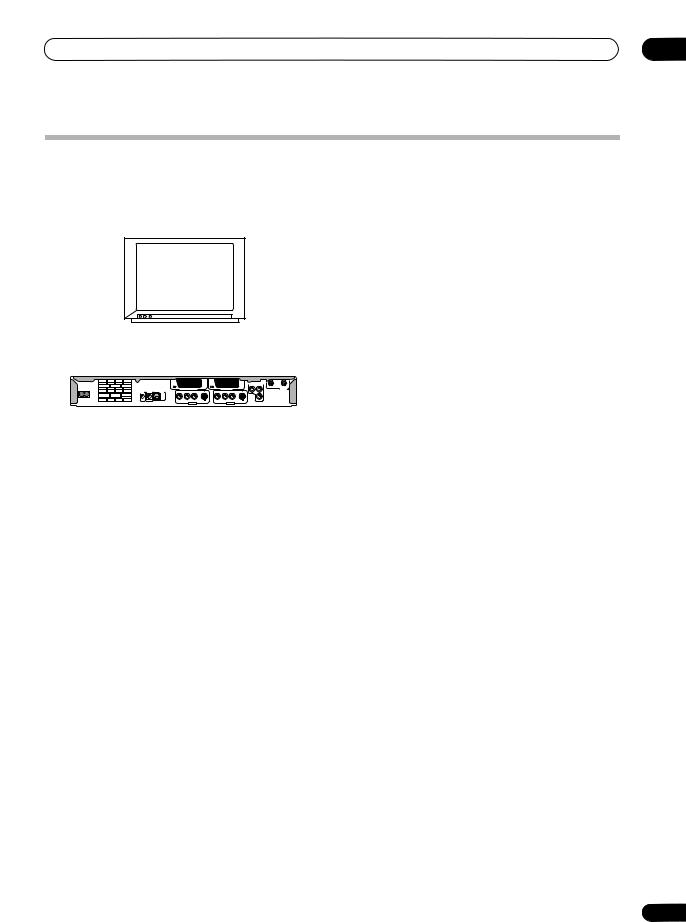
Connecting up |
02 |
Using other types of audio/video output
If you can’t use the SCART AV connector to connect your TV to this recorder, there are standard audio/video output jacks, as well as an S-video and component video output.
Using the supplied audio/video cable
AUDIO |
|
INPUT |
|
VIDEO |
|
INPUT |
|
TV |
|
2 |
1 |
|
COMPONENT VIDEO OUT |
|
|
|
AC IN |
Y |
PB |
IN |
OUT |
AV 2 (INPUT 1/DECODER) |
AV 1 (RGB) – TV |
|
|
ANTENNA |
G-LINK |
CONTROL |
DIGITAL |
R |
L |
|
R |
L |
|
|
|
OUT |
|
|
|
|
|
|
|
|
OPTICAL |
|
|
|
|
|
|
|
IN |
|
AUDIO |
VIDEO |
S-VIDEO |
AUDIO |
VIDEO |
PR |
|
|
S-VIDEO |
||||||
|
|
|
|
INPUT 3 |
|
|
OUTPUT |
|
1Connect the VIDEO OUTPUT jack to a video input on your TV.
Use the yellow jack of the supplied audio/video cable for the video connection.
2Connect the AUDIO OUTPUT jacks to the corresponding audio inputs on your TV.
Use the red and white jacks of the supplied audio/video cable for the audio connection. Make sure you match up the left and right outputs with their corresponding inputs for correct stereo sound.
Using the S-video or component video output
|
COMPONENT |
|
|
|
VIDEO INPUT |
|
|
|
AUDIO |
|
|
|
INPUT |
|
|
|
S-VIDEO |
|
|
2 |
INPUT |
1 |
|
TV |
|||
|
|
|
COMPONENT VIDEO OUT |
|
|
|
AC IN |
Y |
PB |
IN |
OUT |
AV 2 (INPUT 1/DECODER) |
AV 1 (RGB) – TV |
|
|
ANTENNA |
G-LINK |
CONTROL |
DIGITAL |
R |
L |
|
R |
L |
|
|
|
OUT |
|
|
|
|
|
|
|
|
OPTICAL |
|
|
|
|
|
|
|
IN |
|
AUDIO |
VIDEO |
S-VIDEO |
AUDIO |
VIDEO |
PR |
|
|
S-VIDEO |
||||||
|
|
|
|
INPUT 3 |
|
|
OUTPUT |
|
1 Connect the S-video or component video output to a similar input on your TV.
For an S-video connection, use an S-video cable (not supplied) to connect the S-VIDEO OUTPUT jack to an S- video input on your TV
For a component video connection, use a component video cable (not supplied) to connect the COMPONENT VIDEO OUT jacks to a component video input on your TV.
See also Component Video Out on page 101 for how to set up the component video output for use with a progressive scan-compatible TV.
2 Connect the AUDIO OUTPUT jacks to the corresponding audio inputs on your TV.
You can use the supplied audio/video cable, leaving the yellow video plug disconnected. Make sure you match up the left and right outputs with their corresponding inputs for correct stereo sound.
15
En
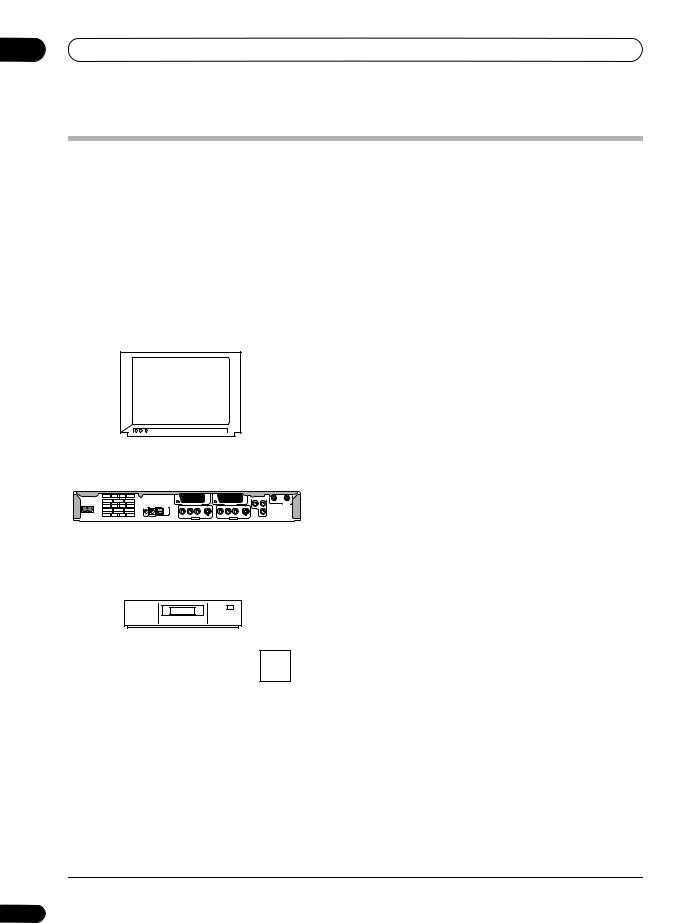
02 Connecting up
Connecting to a cable box, satellite receiver or digital terrestrial receiver
If you have a cable, satellite or digital terrestrial receiver with a built-in decoder, connect it to this recorder and your TV
as shown on this page.1 If you are using a separate decoder box for your cable/satellite TV, set up following the instructions on the next page.
Using the setup on this page you can:
•Record any channel by selecting it on the cable box, satellite receiver or digital terrestrial receiver.
•Change channels and set timer recordings on the external receiver using the GUIDE Plus+™ system (via the G-LINK™ cable, and after setting up).
 Important
Important
•Do not connect this recorder to your TV ‘through’ your VCR, satellite receiver or other component. Always connect each component directly to your TV or AV amplifier/receiver.
SCART AV |
|
|
CONNECTOR |
|
ANTENNA |
|
|
|
|
|
IN |
2 |
TV |
1 |
|
|
ANTENNA
OUT
|
COMPONENT VIDEO OUT |
|
|
|
AC IN |
Y |
PB |
IN |
OUT |
AV 2 (INPUT 1/DECODER) |
AV 1 (RGB) – TV |
|
|
ANTENNA |
G-LINK |
CONTROL |
DIGITAL |
R |
L |
|
R |
L |
|
|
|
OUT |
|
|
|
|
|
|
|
|
OPTICAL |
|
|
|
|
|
|
|
IN |
|
AUDIO |
VIDEO |
S-VIDEO |
AUDIO |
VIDEO |
PR |
|
|
S-VIDEO |
||||||
|
|
|
|
INPUT 3 |
|
|
OUTPUT |
|
|
|
ANTENNA |
|
|
3 |
IN (RF IN) |
|
4 |
1 |
||
|
|||
|
SCART AV |
|
|
|
CONNECTOR |
|
|
|
|
ANTENNA |
|
Cable/Satellite/ |
ANTENNA |
OUT |
|
|
|||
Digital Terrestrial |
IN |
|
|
receiver |
|
Satellite dish/ |
|
|
|
||
|
1 |
antenna/cable TV |
|
|
wall outlet |
1 Connect RF antenna cables as shown.
This enables you to watch and record TV channels.
2Use a SCART cable (not supplied) to connect the AV1(RGB)-TV AV connector to a SCART AV connector on your TV.
This enables you to watch discs.
3Use another SCART cable to connect the AV2(INPUT 1/DECODER) AV connector to a SCART AV connector on your cable box/satellite/digital terrestrial receiver.
This enables you to record scrambled TV channels.
4 Plug the supplied G-LINK™ cable to the G-LINK™ jack.
This enables you to control the tuner in the external receiver using the GUIDE Plus+™ system.
Position the IR transmitter end of the G-LINK™ cable so that the IR receiver on your cable/satellite/digital terrestrial receiver will pick up the control signals (see diagram).
G-LINK |
CONTROL |
DIGITAL |
|
|
OUT |
|
|
OPTICAL |
|
IN |
|
G-LINK cable
See the manual that came with your cable/satellite/ digital terrestrial receiver if you’re not sure where the IR receiver is on the front panel. Alternatively, experiment with the remote control, operating it from very close range until you find the place where the receiver responds.
 Tip
Tip
•This recorder has a ‘through’ function which allows you to record a TV program from the built-in TV tuner in this recorder while watching a video playing on your VCR. (To use this feature when the recorder is in standby, Power Save must be set to Off—see Power Save on page 100).
 Note
Note
1 The diagram shows SCART video connections, but you can alternatively use any of the other audio/video connections.
16
En
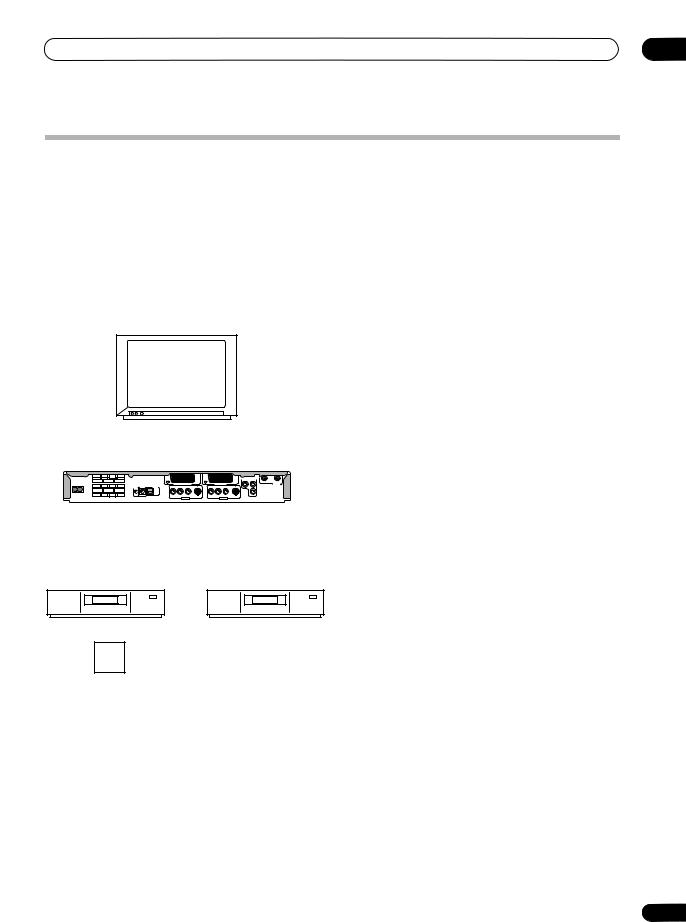
Connecting up |
02 |
Connecting an external decoder box (1)
If you have an external, dedicated decoder box for your satellite or cable TV system, use the setup described on this page. See the previous page for how to connect the G-LINK™ cable.
 Important
Important
•Do not connect your decoder box directly to this recorder.
•Information from the decoder (for example, relating to pay TV services), is only viewable when this recorder is off (in standby).
•For timer recording to work properly on this recorder, the VCR/satellite receiver/cable box must also be switched on during recording.
•It is not possible to watch one TV program and record another using this setup.
SCART AV |
|
CONNECTOR |
|
4 |
TV |
|
COMPONENT VIDEO OUT |
|
|
|
AC IN |
Y |
PB |
IN |
OUT |
AV 2 (INPUT 1/DECODER) |
AV 1 (RGB) – TV |
|
|
ANTENNA |
G-LINK |
CONTROL |
DIGITAL |
R |
L |
|
R |
L |
|
|
|
OUT |
|
|
|
|
|
|
|
|
OPTICAL |
|
|
|
|
|
|
|
IN |
|
AUDIO |
VIDEO |
S-VIDEO |
AUDIO |
VIDEO |
PR |
|
|
S-VIDEO |
||||||
|
|
|
|
INPUT 3 |
|
|
OUTPUT |
|
1Connect the cable from the antenna/cable TV outlet to the antenna input on your VCR/satellite receiver/cable box.
2Use a SCART cable (not supplied) to connect your decoder to your VCR/satellite receiver/cable box.
See the manual for your decoder box for more detailed instructions.
3Use a SCART cable to connect your VCR/satellite receiver/cable box to the AV2(INPUT 1/DECODER) AV connector on this recorder.
4Use a SCART cable to connect the AV1(RGB)-TV AV connector to your TV.
|
3 |
|
|
2 |
|
SCART AV |
SCART AV |
|
CONNECTOR |
CONNECTOR |
|
Decoder |
VCR/Satellite receiver |
ANTENNA |
|
/Cable box |
|
|
IN |
|
|
|
 1
1
Antenna/cable TV wall outlet
17
En
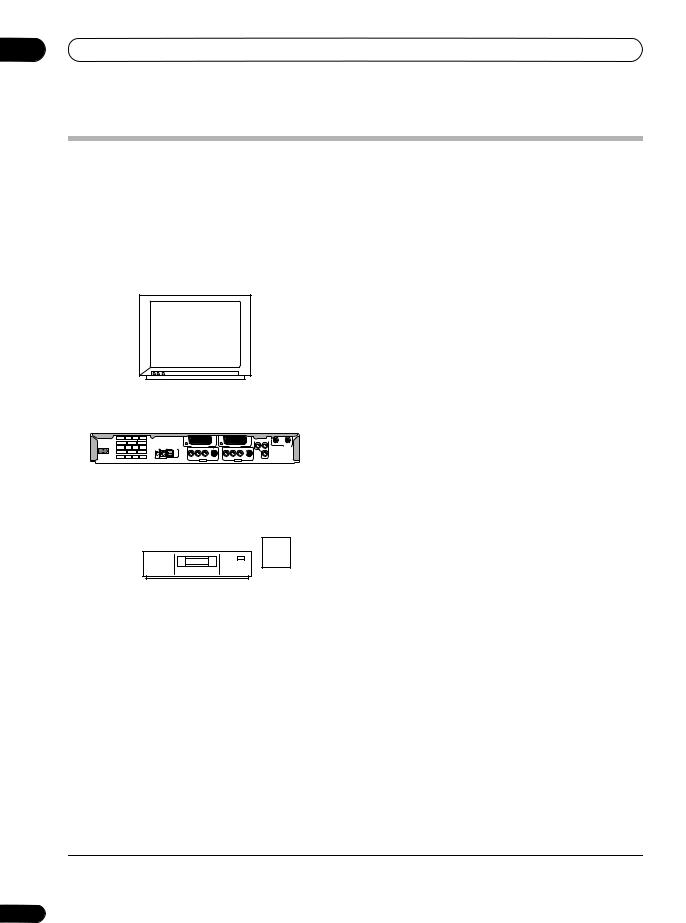
02 Connecting up
Connecting an external decoder box (2)
If you only have a decoder, connect it to this recorder and your TV as shown on this page.1
Using the setup on this page you can:
• Record scrambled channels received using the recorder’s built-in TV tuner.
 Important
Important
•Do not connect this recorder ‘through’ your VCR, satellite receiver or cable box. Always connect each component directly to your TV or AV amplifier/receiver.
SCART AV |
|
|
CONNECTOR |
|
ANTENNA |
|
|
|
|
|
IN |
2 |
TV |
1 |
ANTENNA
OUT
|
COMPONENT VIDEO OUT |
|
|
|
AC IN |
Y |
PB |
IN |
OUT |
AV 2 (INPUT 1/DECODER) |
AV 1 (RGB) – TV |
|
|
ANTENNA |
G-LINK |
CONTROL |
DIGITAL |
R |
L |
|
R |
L |
|
|
|
OUT |
|
|
|
|
|
|
|
|
OPTICAL |
|
|
|
|
|
|
|
IN |
|
AUDIO |
VIDEO |
S-VIDEO |
AUDIO |
VIDEO |
PR |
|
|
S-VIDEO |
||||||
|
|
|
|
INPUT 3 |
|
|
OUTPUT |
|
ANTENNA
IN (RF IN)
3 |
1 |
SCART AV |
|
CONNECTOR |
|
|
Antenna/cable TV |
Decoder |
wall outlet |
1 Connect RF antenna cables as shown.
This enables you to watch and record TV channels.
2Use a SCART cable (not supplied) to connect the AV1(RGB)-TV AV connector to a SCART AV connector on your TV.
This enables you to watch discs.
3Use another SCART cable to connect the AV2(INPUT 1/DECODER) AV connector to a SCART AV connector on your decoder box.
This enables you to record scrambled TV channels.
 Note
Note
1 In order to use this setup, you will need to make the following settings from the Initial Setup menu:
•Set the AV2/L1 In setting to Decoder from the Initial Setup menu (see AV2/L1 In on page 102).
•From the Manual CH Setting screen, set the Decoder setting for the scrambled channels to On (see Manual CH Setting on page 101).
18
En
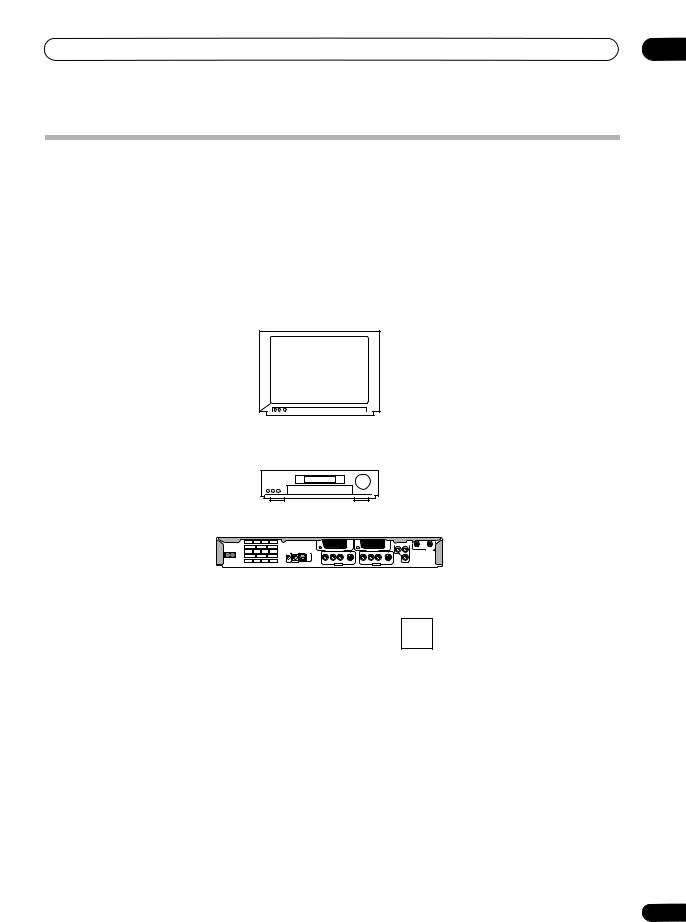
Connecting up |
02 |
Connecting to an AV amplifier/receiver
To enjoy multichannel surround sound you need to connect this recorder to an AV amplifier/receiver using the digital optical output.
In addition to a digital connection, we recommend also connecting using the stereo analog connection for compatibility with all discs and sources.
You’ll probably also want to connect a video output to your AV amplifier/receiver. Use the ordinary video output (as shown here), or the S-video output.
 Important
Important
•Noise may be output from your speakers if the recorder is not set up to work with your AV amplifier/receiver properly (see Audio Out Settings on page 103).
ANTENNA
IN
VIDEO
IN
TV
|
|
|
4 |
1 |
|
AUDIO/VIDEO |
VIDEO |
|
|
|
IN |
OUT |
DIGITAL |
|
|
|
|
IN |
|
3 |
AV amp/ |
|
2 |
ANTENNA |
receiver |
|
|
OUT |
AC IN
G-LINK CONTROL
IN
|
|
|
|
|
|
COMPONENT VIDEO OUT |
|
|
|
|
|
|
|
|
|
Y |
PB |
IN |
OUT |
|
AV 2 (INPUT 1/DECODER) |
|
AV 1 (RGB) – TV |
|
|
|
ANTENNA |
||
DIGITAL |
R |
L |
|
R |
L |
|
|
|
|
OUT |
|
|
|
|
|
|
|
|
|
OPTICAL |
|
|
|
|
|
|
|
|
|
|
AUDIO |
VIDEO |
S-VIDEO |
AUDIO |
VIDEO |
S-VIDEO |
PR |
|
|
|
|
INPUT 3 |
|
|
OUTPUT |
|
|
|
|
ANTENNA
IN (RF IN)
1
1 Connect RF antenna cables as shown.
This enables you to watch and record TV channels.
2Connect one of the DIGITAL OUT OPTICAL jack on this recorder to an optical digital input on your AV amplifier/receiver.
This enables you to listen to multichannel surround sound.
3Connect the analog AUDIO OUTPUT and VIDEO OUTPUT jacks on this recorder to an analog audio and video input on your AV amplifier/receiver.
4Connect the AV amplifier/receiver’s video output to a video input on your TV.
Antenna/cable TV wall outlet
 Important
Important
•Do not connect this recorder to your TV ‘through’ your VCR using A/V cables. Always connect it directly to your TV.
19
En

02 Connecting up
Connecting other AV sources
Connecting a VCR or analog camcorder
AUDIO/VIDEO |
AUDIO/VIDEO |
OUTPUT |
INPUT |
1 |
2 |
|
Analog camcorder |
AUDIO/VIDEO |
AUDIO/VIDEO |
INPUT |
OUTPUT |
|
VCR |
1Connect a set of audio and video inputs of your VCR or camcorder to a set of outputs on this recorder.
This enables you to record from this recorder to your VCR or camcorder.
•You can use standard video or S-video cables for the video connection.
•Alternatively, you can use the AV2(INPUT 1/ DECODER) SCART connector for audio/video input and output with just one SCART cable.
2Connect a set of audio and video outputs of your VCR or camcorder to a set of inputs on this recorder.
This enables you to record tapes from your VCR or camcorder.
•You can use standard video or S-video cables for the video connection.
•The front panel connections make convenient connections for a camcorder input.
Connecting a DV camcorder
Using the front panel DV IN jack, it is possible to connect a DV camcorder or video deck, or DVD-R/RW recorder and digitally transfer DV tapes or DVD-R/RW discs to DVD-R/RW.
 Important
Important
•This jack is for connection to DV equipment only. It is not compatible with digital satellite receivers or D- VHS video decks.
DV
IN
DV
OUT
DV camcorder
1 Use a DV cable (not supplied) to connect the DV jack of your DV camcorder/video deck to the front panel DV IN jack of this recorder.
Plugging in
After checking all the connections, plug in the recorder.
1 Use the supplied power cable to connect this recorder to a power outlet.
20
En
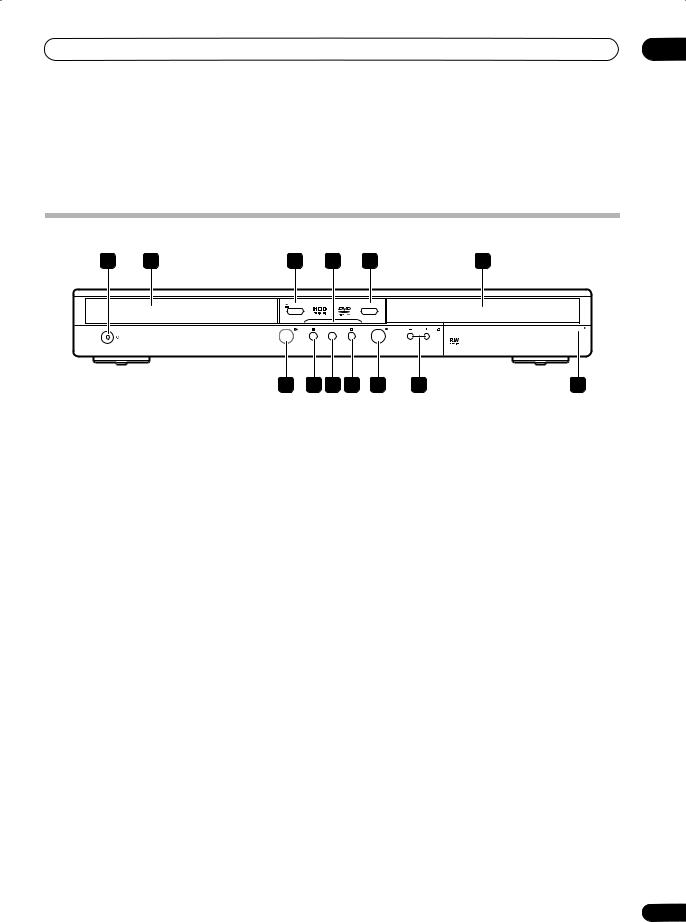
Controls and displays |
03 |
Chapter 3
Controls and displays
Front panel
1 |
2 |
3 |
4 |
5 |
6 |
|
|
OPEN/CLOSE |
|
HDD/DVD |
|
|
|
|
ONE TOUCH COPY |
REC |
PULL-OPEN |
|
STANDBY/ON |
|
|
|
|
13 |
12 11 10 |
9 |
8 |
7 |
1 STANDBY/ON
Press to switch the recorder on/into standby.
2Disc tray
3OPEN/CLOSE
Press to open/close the disc tray.
4 HDD/DVD indicator
Lights blue when the HDD is selected; orange when DVD is selected.
5 HDD/DVD
Press to switch between the hard disk drive (HDD) and DVD for recording and playback.
6Front panel display and IR remote sensor
See Display on page 24 for details.
7Front panel inputs (page 12)
Pull the cover down where indicated to access the front panel input jacks (audio, video and DV). Especially convenient for connecting camcorders and other portable equipment.
8 +/–
Use to change channels, skip chapters/tracks, etc.
9 REC
Press to start recording. Press repeatedly to set the recording time in 30 minute blocks.
10
Press to stop recording.
11 ONE TOUCH COPY (page 71)
Press to start One Touch Copy of the currently playing title to DVD or the HDD. See also the Note on copying on page 7.
12
Press to stop playback.
13
Press to start or restart playback.
21
En
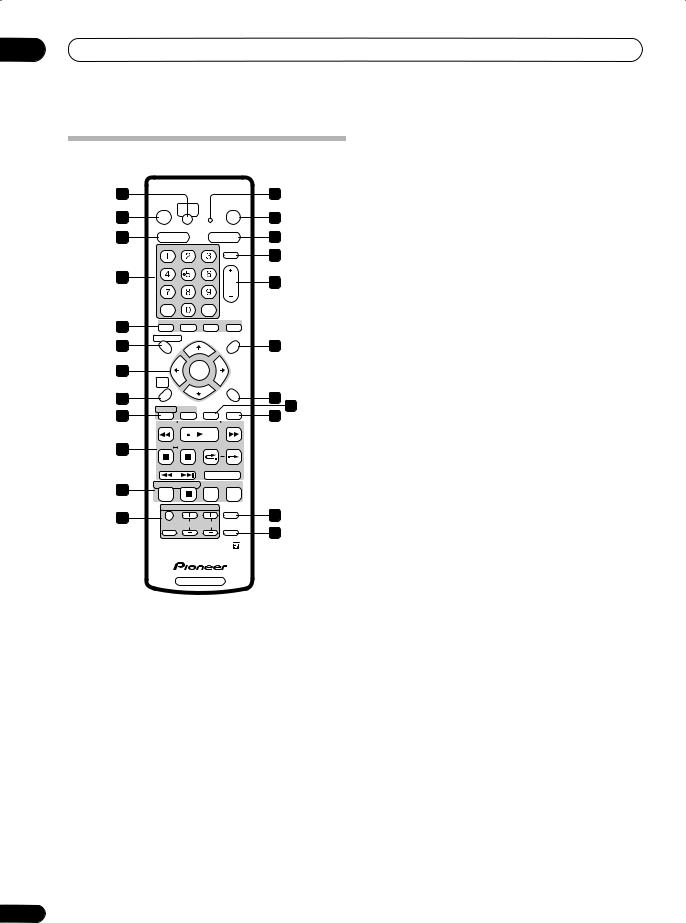
03 Controls and displays
Remote control
1 |
|
|
|
|
2 |
|
STANDBY/ON |
ONE TOUCH |
|
OPEN/CLOSE |
|
3 |
|
COPY |
|
|
4 |
|
|
|
|
||
5 |
HDD |
|
|
DVD |
6 |
|
|
ABC |
DEF |
INPUT |
|
|
|
SELECT |
7 |
||
|
|
|
|
||
|
|
|
|
|
|
|
GHI |
JKL |
MNO |
|
|
8 |
PQRS |
TUV |
WXYZ CH |
9 |
|
|
|||||
+CLEAR
CLEAR
10 |
AUDIO |
SUBTITLE |
ANGLE |
PLAY MODE |
|
|
|
|
|
|
|
11 |
DISC NAVIGATOR |
|
|
MENU |
12 |
|
|
|
|
||
|
TOP MENU |
|
|
|
|
13 |
|
ENTER |
|
|
|
|
HOME |
|
|
|
|
|
MENU |
|
|
RETURN |
|
14 |
GUIDE |
INFO |
HELP |
DISPLAY |
15 17 |
16 |
REV SCAN |
PLAY |
FWD SCAN |
18 |
|
|
|
||||
19 |
PAUSE |
STOP OK |
BACK CM SKIP |
|
|
|
|
|
|
|
|
|
CASE |
|
STEP/SLOW |
|
|
|
PREV SELECTION NEXT |
|
|||
20 |
REC |
STOPREC |
REC MODE |
TIMER REC |
|
|
|
|
|
|
|
|
|
TV CONTROL |
|
TV/DVD |
22 |
21 |
|
|
|
||
INPUT |
CHANNEL |
VOLUME |
TV DIRECT |
||
|
SELECT |
REC |
23 |
||
|
|
|
|||
|
|
|
|
|
|
DVD RECORDER
1 ONE TOUCH COPY (page 71)
Press to start One Touch Copy of the currently playing title to DVD or the HDD.
2 Remote control indicator
Lights when setting up the remote control for use with a TV (page 109) and when setting the remote control mode (page 106).
3 STANDBY/ON
Press to switch the recorder on/into standby.
4 OPEN/CLOSE
Press to open/close the disc tray.
5 HDD (page 30)
Press to select the hard disk (HDD) for recording or playback.
22
6 DVD (page 30)
Press to select the DVD for recording or playback.
7 INPUT SELECT (page 57)
Press to change the input to use for recording.
8 Alphanumeric buttons, + and CLEAR
Use the number buttons for track/chapter/title selection; channel selection, and so on. The same buttons can also be used to enter names for titles, discs and so on.
Use the + button to enter non-alphanumeric characters and symbols.
Use CLEAR to clear an entry and start again.
9 CH +/– (page 31)
Press to change the channel of the built-in TV tuner.
10GUIDE Plus+™ Action buttons and DVD playback functions
When in the GUIDE Plus+™ system, these buttons act as the Red, Green, Yellow and Blue Action buttons (the functions of these buttons change according to the GUIDE Plus+™ Area. (page 38)
AUDIO (page 31, 69)
Changes the audio language or channel. (When the recorder is stopped, press to change the tuner audio.)
SUBTITLE (page 68)
Displays/changes the subtitles included in multilingual DVD-Video discs.
ANGLE (page 70)
Switches camera angles on discs with multi-angle scenes.
PLAY MODE (page 65)
Press to display the Play Mode menu (for features such as search, repeat and program play).
11DISC NAVIGATOR (page 62, 81) / TOP MENU
(page 33)
Press to display the Disc Navigator screen, or the top menu if a DVD-Video disc is loaded.
12MENU (page 33)
Press to display the disc menu if a DVD-Video disc is loaded.
When in the GUIDE Plus+™ system, use to jump directly to the Menu bar.
13 / / / and ENTER
Used to navigate all on-screen displays. Press ENTER to select the currently highlighted option.
14 HOME MENU (page 35)
Press to display the Home Menu, from which you can navigate all the functions of the recorder.
En

Controls and displays |
03 |
15 RETURN
Press to go back one level in the on-screen menu or display.
16GUIDE Plus+™ system controls
GUIDE
Press to display the GUIDE Plus+™ screen; press again to exit.
INFO
Press to see additional information for the highlighted item in GUIDE Plus+™.
17HELP
Press for help on how to use the current GUI screen.
18DISPLAY (page 35)
Displays/changes the on-screen information displays.
19Playback controls (page 32)
REV SCAN / FWD SCAN (page 64) Press to start reverse or forward scanning. Press again to change the speed.
PLAY
Press to start playback.
PAUSE
Press to pause playback or recording.
STOP
Press to stop playback.
CM BACK (commercial back)
Press repeatedly to skip progressively backward through the audio or video playing.
CM SKIP (commercial skip)
Press repeatedly to skip progressively forward through the audio or video playing.
PREV / NEXT
Press to skip to the previous or next title/chapter/ track/folder; or to display the previous or next menu page.
When GUIDE Plus+™ is displayed, use to display the previous/next page.
STEP/SLOW (page 64)
During playback, press to start slow-motion playback; while paused, press to show the previous or next video frame.
When GUIDE Plus+™ is displayed, use to display the previous/next day.
20 Recording controls (page 30)
REC
Press to start recording. Press repeatedly to set the recording time in blocks of 30 mins.
STOP REC
Press to stop recording.
REC MODE (page 51)
Press repeatedly to change the recording mode (picture quality).
TIMER REC (page 39)
Press to set a timer recording from the GUIDE Plus+™ system.
21 TV CONTROL (page 109)
After setting up, use these controls to control your TV.
22 TV/DVD (page 32)
Press to switch between ‘TV mode’, in which you get the picture and sound from the TV’s tuner, and ‘DVD mode’, in which you get picture and sound from the recorder’s tuner (or an external input).
23 TV DIRECT REC (page 52)
Press to start recording whatever channel your TV is set to.
23
En
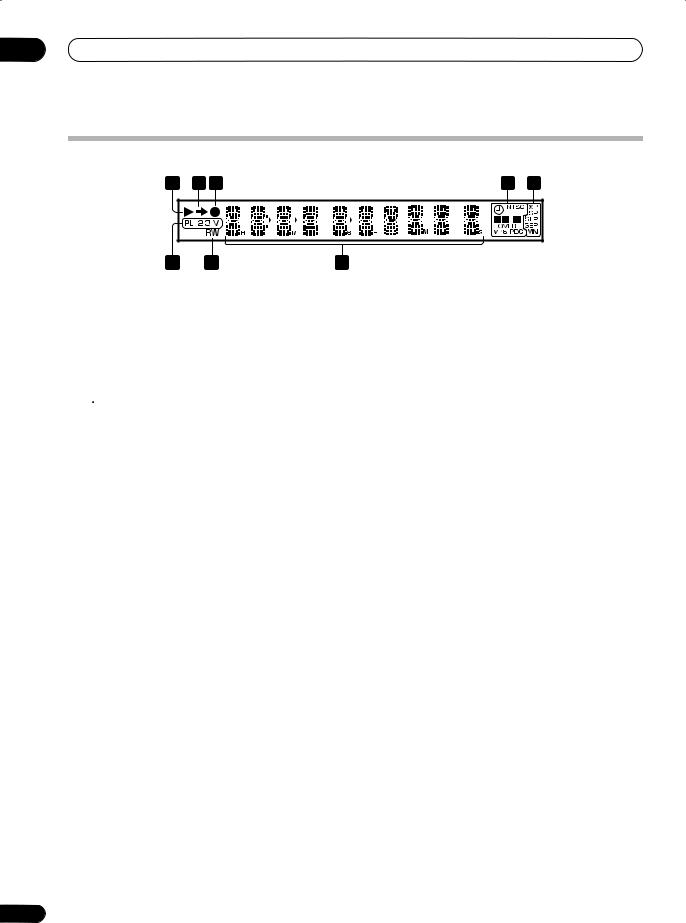
03 Controls and displays
Display
1 |
2 |
3 |
4 |
5 |
|
|
|
L R |
P |
8 |
|
7 |
6 |
|
1
Lights during playback; blinks when playback is paused.
2
Lights when copying.
3
Lights during recording; blinks when recording is paused.
4 (page 39)
(page 39)
Lights when a timer recording has been set. (Indicator blinks if the timer has been set to DVD but there isn’t a recordable disc loaded, or the timer has been set to HDD but the HDD is not recordable.)
NTSC
Lights when playing NTSC format video.

 (page 102)
(page 102)
Indicates which channels of a bilingual broadcast are recorded.
 (page 101)
(page 101)
Lights when the component video output is set to progressive scan.
OVER (page 103)
Lights when the analog audio input level is too high.
VPS / PDC (page 53)
Lights when receiving a VPS/PDC broadcast during a VPS/PDC-enabled timer recording.
5Recording quality indicators (page 50)
XP
Lights when the recording mode is set to XP (best quality).
SP
Lights when the recording mode is set to SP (standard play).
LP / SLP
Lights when the recording mode is set to LP (long play) or SLP (super long play).
EP / SEP
Lights when the recording mode is set to EP (extended play) or SEP (super extended play).
MN
Lights when the recording mode is set to MN (manual recording level) mode.
6Character display
7R / RW
Indicates the type of recordable DVD loaded: DVD-R or DVD-RW.
8PL (page 81)
Lights when a VR mode disc is loaded and the recorder is in Play List mode.
2 3 (page 106)
Shows the remote control mode (if nothing is displayed, the remote control mode is 1).
V
Lights when an unfinalized Video mode disc is loaded.
24
En
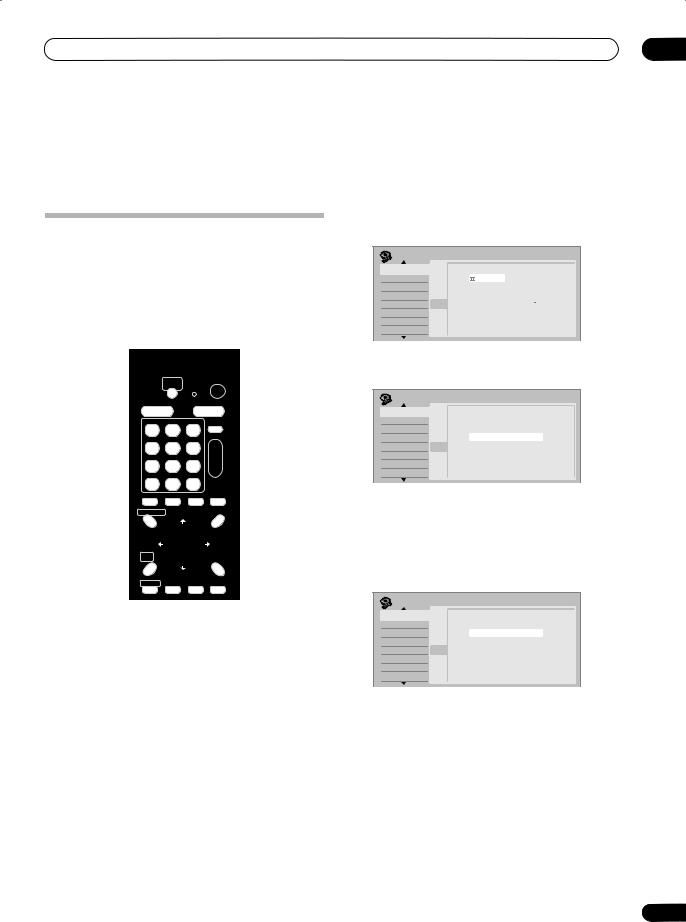
Getting started
Chapter 4
Getting started
Switching on and setting up
When you switch the recorder on for the first time, you can make several basic settings using the Setup Navigator feature. This takes you through setting the clock, the internal TV tuner and the video output settings.
If you’re using the recorder for the first time, we strongly recommend you use the Setup Navigator before starting to use the recorder.
STANDBY/ON
ENTER
1 Switch on your TV and set the video input to this recorder.
2 Press the STANDBY/ON button on the remote control or the front panel to switch on.
When you switch on for the first time, your TV should display the Setup Navigator screen. (If the Setup Navigator doesn’t appear, you can also access it from the Initial Setup menu; see page 100).
•If this recorder is connected to a compatible TV using a fully-wired 21-pin SCART cable, the recorder will take a few seconds to download country, TV screen size and language information. (Check the manual that came with your TV for compatibility information.)
04
3 Use the / buttons to choose a language, then press ENTER.
Initial Setup |
|
|
|
Basic |
Clock SettingLanguage |
|
|
Tuner |
Input Line SystemEnglish |
français |
|
Video In/Out |
Power Save |
Deutsch |
Italiano |
Audio In |
Help |
Español |
Nederlands |
Audio Out |
Setup Navigator Svenska |
PyccKNN |
|
Language |
|
|
|
Recording |
|
|
|
Playback |
|
|
|
4 Press ENTER to start setting up using the Setup Navigator.
Initial Setup |
|
|
Basic |
Clock Setting |
|
Tuner |
|
Complete this setup before you |
Input Line System |
||
Video In/Out |
|
start using your recorder. |
Power Save |
||
Audio In |
Help |
Start |
Audio Out |
Setup Navigator Cancel |
|
Language |
|
Please use the Initial Setup if you |
|
|
|
Recording |
|
want to make more detailed settings. |
Playback
•If you don’t want to use the Setup Navigator, press to select Cancel, then press ENTER to exit the Setup Navigator.
5 Select the Auto Channel Setting (‘Auto Scan’ or ‘Download from TV’), or ‘Do not set’, then press ENTER.
Initial Setup |
|
|
Basic |
Clock SettingAutoChannel Setting |
|
Tuner |
Input Line System |
|
Video In/Out |
Power Save |
AutoEnglishScan |
Audio In |
Help |
Download from TV |
Audio Out |
Setup Navigator Do not Set |
|
Language |
|
|
Recording |
|
|
Playback |
|
|
•Select Do not set if you want to skip setting up the channels (because they have already been set up, for example).
•You can only use the Download from TV feature if you connected this recorder to your TV using a fully-wired 21-pin SCART cable connected to the AV1(RGB)-TV connector, and if your TV supports this function (check your TV’s instruction manual for more details).
25
En
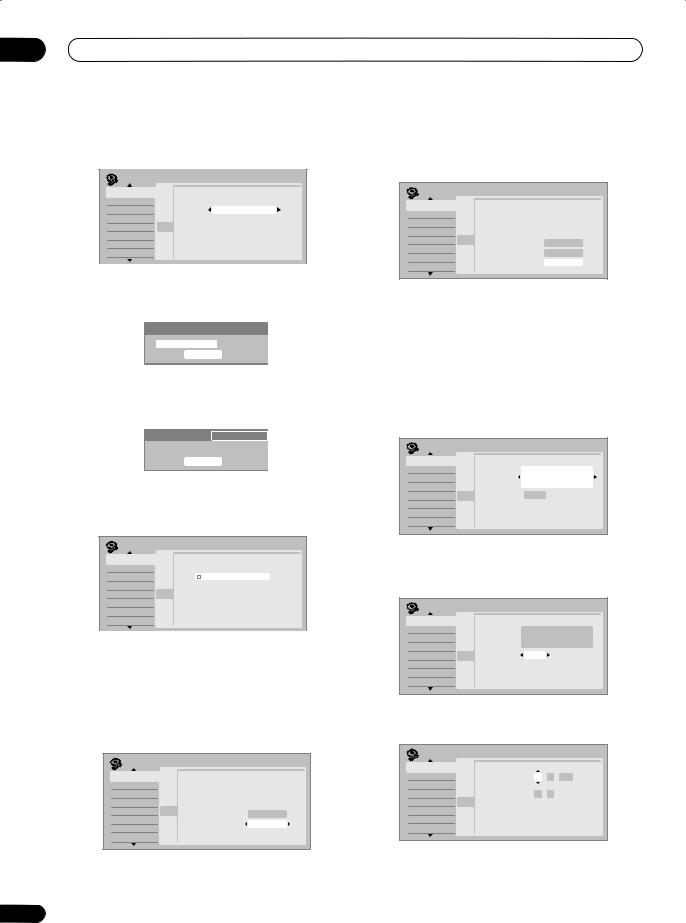
04 Getting started
• Use the / buttons to choose your country, then press ENTER.
Initial Setup |
|
|
Basic |
Clock SettingCountry Selection |
|
Tuner |
Input Line System |
|
Video In/Out |
Power SaveCountry |
Austria |
Audio In |
Help |
|
Audio Out |
Setup Navigator |
|
Language |
|
|
Recording |
|
|
Playback |
|
|
•Auto-tuning channels
The Auto Scan option automatically scans and sets the channel presets.
Tuning
32/213
Cancel
•Downloading channels from your TV
Use the Download from TV option to download all the channels that your TV is tuned to.
Downloading |
Pr 5 |
32/213
Cancel
6 Select ‘Auto’ for automatic time setting, or ‘Manual’ to set the clock manually, then press ENTER.
Initial Setup |
|
|
Basic |
Clock SettingClock Setting |
|
Tuner |
Input Line System |
|
Video In/Out |
Power Save |
Auto |
Audio In |
Help |
Manual |
Audio Out |
Setup Navigator |
|
Language |
|
|
Recording |
|
|
Playback |
|
|
•Auto clock setting
Some TV channels broadcast time signals together with the program. This recorder can use these signals to set the clock automatically.
Set ‘Clock Set CH‘ to the channel preset number that broadcasts a time signal, then move the cursor down to ‘Start’ and press ENTER.
Initial Setup |
|
|
|
|
|
Basic |
Clock SettingAutoClock Setting |
|
|
|
|
Tuner |
Input Line System |
–– |
/ |
–– / –––– |
|
Video In/Out |
|
Date |
|||
Power Save |
|
|
|
||
Audio In |
Help |
Time |
–– |
: |
–– |
Audio Out |
Setup Navigator |
|
|
Pr 1 |
|
|
|
Clock Set CH |
|
|
|
Language
Start
Recording
Playback
26
The recorder takes a short while to set the time. After you see that the time has been set, select Next to proceed.
Initial Setup |
|
|
|
|
|
|
Basic |
Clock SettingAutoClock Setting |
|
|
|
||
Tuner |
Input Line System |
SAT |
01 |
/ |
01 / 2005 |
|
Video In/Out |
|
Date |
||||
Power Save |
|
|
|
|
||
Audio In |
Help |
Time |
|
11 |
: |
20 |
Audio Out |
Setup Navigator |
|
|
|
Pr 1 |
|
|
|
Clock Set CH |
|
|
|
|
Language
Start
Recording
Next
Playback
If the time could not be set automatically, press RETURN to go back to the previous screen and select
Manual.
•Manual clock setting
If no stations in your area are broadcasting time signals, you can set the clock manually.
Use the / buttons to set your time zone.
You can set this by selecting a city or a time relative to GMT.
Initial Setup |
|
|
Basic |
Clock SettingManual Clock Setting |
1/2 |
|
||
Tuner |
Input Line System |
Austria |
Video In/Out |
Time Zone |
|
Power Save |
Vienna |
|
Audio In |
Help |
|
Audio Out |
Setup NavigatorSummer Time |
Off |
Language |
|
|
Recording |
|
|
Playback |
|
|
Press then use the / buttons to select ‘On’ or ‘Off’ for summer time, then press ENTER.
Select On if you are currently using summer time.
Initial Setup |
|
|
Basic |
Clock SettingManual Clock Setting |
1/2 |
|
||
Tuner |
Input Line System |
Austria |
Video In/Out |
Time Zone |
|
Power Save |
Vienna |
|
Audio In |
Help |
|
Audio Out |
Setup NavigatorSummer Time |
On |
Language |
|
|
Recording |
|
|
Playback |
|
|
Set the date (day/month/year) and time, then press ENTER to make all the settings.
Initial Setup |
|
|
|
|
Basic |
Clock SettingManual Clock Setting |
2/2 |
||
|
||||
Tuner |
Input Line System |
SAT |
01 / 01 / 2005 |
|
|
|
Date |
||
Video In/Out |
Power Save |
|
|
|
Audio In |
Help |
Time |
|
00 : 00 |
Audio Out |
Setup Navigator |
|
Austria |
|
Language |
|
Time Zone |
|
|
|
|
Vienna |
||
Recording |
|
|
|
|
|
|
|
|
|
Playback |
|
Summer Time |
|
On |
Use the / buttons to change the value in the highlighted field.
En
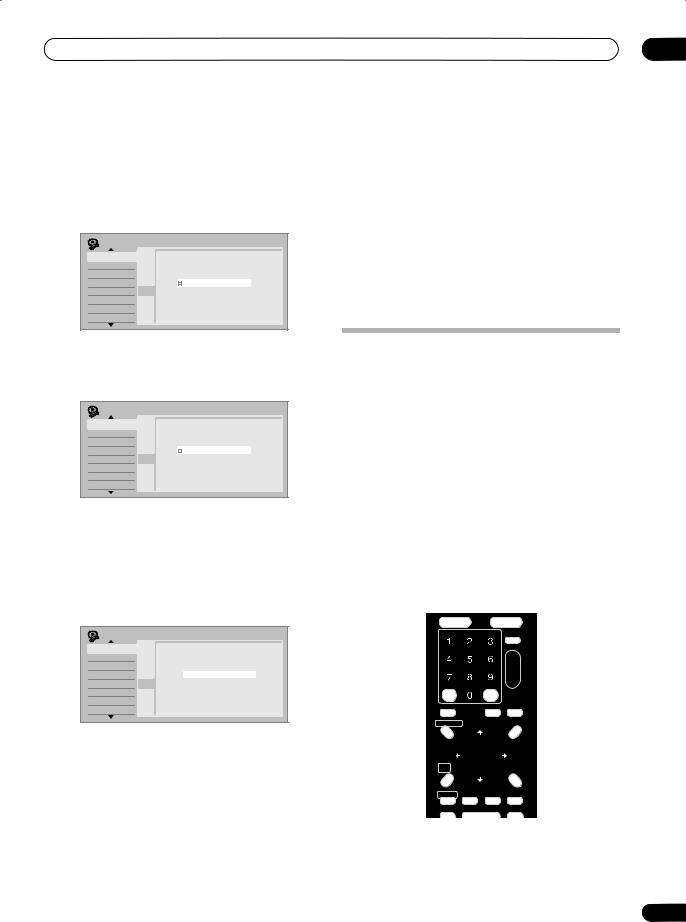
Getting started |
04 |
Use the / buttons to move from one field to another.
•You can go back to the previous screen at anytime in the Setup Navigator by pressing RETURN.
7 Select the TV screen type, ‘Wide (16:9)’ or ‘Standard (4:3)’.
Initial Setup |
|
|
Basic |
Clock SettingTVScreen Size |
|
Tuner |
Input Line System |
|
Video In/Out |
Power Save |
Wide (16:9) |
Audio In |
Help |
Standard (4:3) |
Audio Out |
Setup Navigator |
|
Language |
|
|
Recording |
|
|
Playback |
|
|
•Manual channel setting – This setting lets you skip channels where there is no station, as well as manually tune to stations. See Manual CH Setting on page 101.
•Setting up the remote to control your TV – You can set up the supplied remote control to control many brands of TV. See Setting up the remote to control your TV on page 109.
•If for any reason you need to cancel the setup process before it’s completed, you will be asked the next time you switch on whether you want to start setting up again, or whether to leave it until later.
Use the / buttons to select, then press ENTER.
8 Is your TV compatible with progressive scan video?
Initial Setup |
|
|
Basic |
Clock SettingProgressive |
|
Tuner |
Input Line System |
|
Video In/Out |
Power Save |
Compatible |
Audio In |
Help |
Not Compatible |
Audio Out |
Setup Navigator Don't Know |
|
Language |
|
|
Recording |
|
|
Playback |
|
|
Use the / buttons to select Compatible, Not Compatible, or Don’t Know, then press ENTER.
•Note that progressive scan video is only output through the AV1(RGB)-TV connector and the component video outputs.
9 Press ENTER to exit the Setup Navigator, or select ‘Go Back’ if you want to start again.
Initial Setup |
|
|
Basic |
Clock Setting |
|
Tuner |
Input Line Systemetupis complete! |
|
Video In/Out |
Power SaveEnjoy using your DVD recorder! |
|
Audio In |
Help |
Finish Setup |
Audio Out |
Setup Navigator |
Go Back |
Language |
|
|
Recording |
|
|
Playback |
|
|
That completes basic setup using the Setup Navigator.
Other settings you can make
After setting up using the Setup Navigator, you should be ready to start enjoying your DVD recorder. It’s possible, however, that you may want to make a couple of additional settings, depending on how the recorder is set up for terrestrial TV broadcasts.
Setting up the GUIDE Plus+™ system
The GUIDE Plus+™ system is a free, interactive onscreen television programming guide. The system offers program listings for all major channels, one-touch recording, search by genre, recommendations according to your profile and more.
For the GUIDE Plus+ system to function correctly, it is important that you set the language and country correctly in the Setup Navigator, and that you have performed a scan for available channels, as these are all used by the GUIDE Plus+ system. If any of these things are not yet set, please run the Setup Navigator first (see
Switching on and setting up on page 25).
TV listings information is received via ‘host channels’. In order to receive the correct TV listings information for your country or region you need to set up the GUIDE Plus+ system and ‘download’ the TV listings information. The initial download can take up to 24 hours, but once this is done, all future updates are automatic.
ENTER
27
En
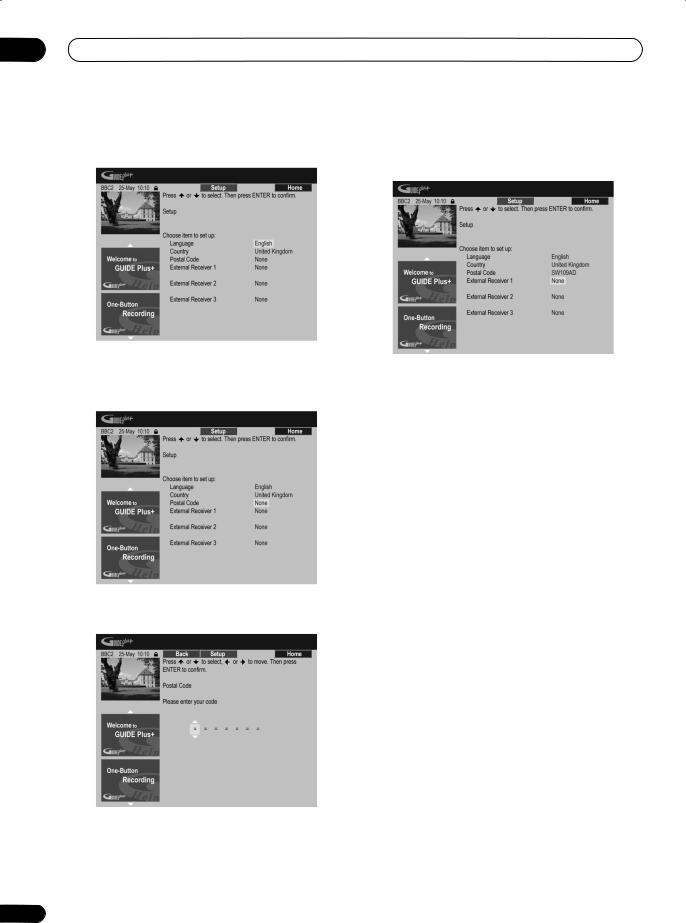
04 Getting started
1 Press GUIDE to display the GUIDE Plus+ setup menu.
4 If you are using an external receiver (such as a satellite receiver) with the supplied G-LINK cable, complete this step, otherwise jump to step 5 below.
The language and country settings are already set to whatever you selected in the Setup Navigator.
2 Use the / buttons to select Postal Code.
3 Use the number and cursor buttons to enter your postal code.
The system uses your postal code to identify which TV listings data is correct for the area in which you live, so it is important that you enter it correctly.
28
•See Connecting to a cable box, satellite receiver or digital terrestrial receiver on page 16 for more on using the supplied G-LINK cable.
•Select External Receiver 1, 2 or 3, then press ENTER. (If you have just one external receiver, use External Receiver 1. You can add further receivers in 2 and 3 if you need to.)
After pressing ENTER:
•Select your reception method (Terrestrial, Cable or
Satellite).
•Select your provider (if applicable).
•Select the brand of your external receiver.
•Identify which input your external receiver is connected to.
After completing these steps the recorder will try and communicate with your external receiver and change the channel via the G-LINK cable. If the channel was successfully changed, select Yes to confirm.
If the channel did not change, select No. The GUIDE Plus+ system will try other codes assigned to your external receiver. If none of the codes changes the channel successfully, tune your external receiver to the host channel for your country (refer to step 5 below) and leave it on overnight. The recorder needs to be in standby. It will wake up automatically and download new codes from the host channel. The next day, try this setup process again:
•Press GUIDE to display the GUIDE Plus+ setup menu.
•Press to highlight the Menu bar, then use to reach the Setup area and select Setup.
•Continue setting up from the start of this step again.
If your external receiver still doesn’t respond to the G-LINK controller, please call customer support and report the brand and model of your external receiver.
En
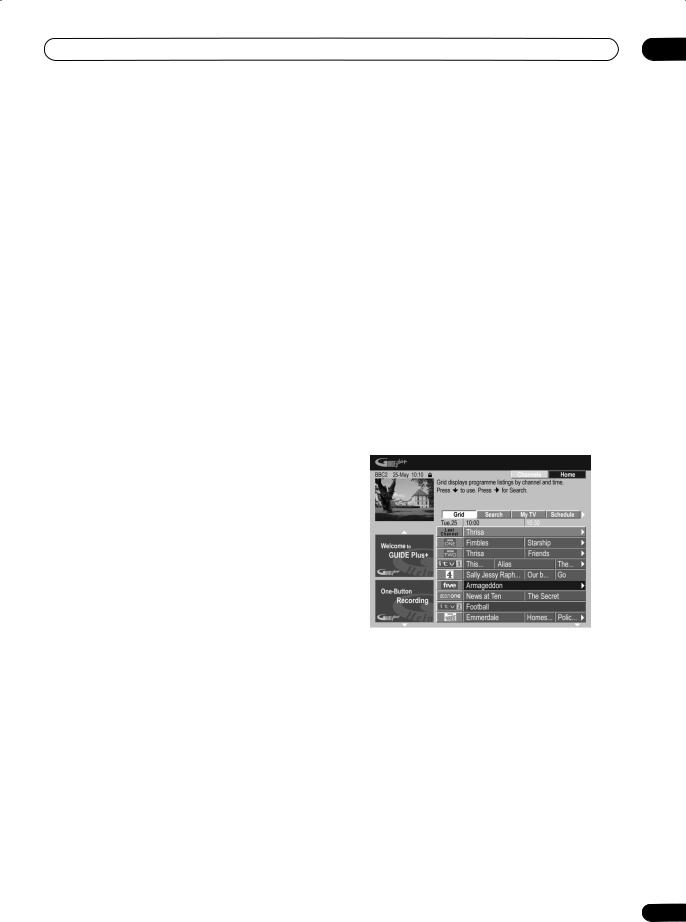
Getting started |
04 |
See also GUIDE Plus+ FAQ and troubleshooting on page 47.
5 Identify the host channel for your country.
The TV listings information available in GUIDE Plus+ is distributed throughout Europe by selected broadcasters called host channels. It is important that the host channel for your country is correctly identified in order to receive listings information (EPG download).
AIf you are not using an external receiver, this recorder will automatically scan all channels for the host channel:
•Leave the recorder in standby overnight (do not leave it switched on).
BIf you are using an external receiver, you need to identify the host channel from the table below:
Country/ |
Host channels |
Comments |
|
Region |
|||
|
|
||
|
|
|
|
Austria |
Eurosport |
|
|
|
|
|
|
Belgium |
Music Factory (TMF) |
|
|
(Flemish) |
|
|
|
|
|
|
|
France |
Canal+ |
Analog only |
|
|
|
|
|
Germany |
Eurosport |
|
|
|
|
|
|
Italy |
Sport Italia |
Analog only |
|
|
|
|
|
Netherlands |
Music Factory (TMF), |
Use TMF if you live in |
|
|
Eurosport |
Amsterdam, Eindhoven or |
|
|
|
Rotterdam. |
|
|
|
|
|
Spain |
Tele 5 |
Analog only |
|
|
|
|
|
Switzerland |
Eurosport |
|
|
|
|
|
|
UK |
ITV, Eurosport |
ITV is analog only. Use |
|
|
|
Eurosport if you are a SKY |
|
|
|
subscriber and you no longer |
|
|
|
have a terrestrial antenna. |
|
|
|
|
•If you cannot receive any of the host channels (see the above table) then you won’t be able to use the GUIDE Plus+ system. In this case do not set the postal code (or set Country to Other) in the GUIDE Plus+ setup screen. (When GUIDE Plus+ service starts in your area, set the postal code again.)
•Even if you can’t use the EPG functions where you live, you can still set ShowView timer recordings and manual recordings — see Setting a timer recording on page 53.
•The front panel display shows EPG when receiving data. If you power on the recorder during an EPG download, the download is canceled.
•EPG data may be received several times a day. All updates are automatic.
•When downloading EPG data, the recorder may sound as though it is on. This is normal.
Checking the downloaded data the following day
1 Press GUIDE.
•Tune your external receiver to the appropriate host channel and leave the receiver on and the recorder in standby overnight.
C If you use both an external receiver and this recorder as sources, follow the instructions above for setting up without an external receiver. Only if this is unsuccessful try the external receiver method.
About EPG download
•EPG data can only be received when the recorder is in standby. (When not using the recorder, therefore, please switch it into standby.) If you’re using an external receiver, leave this on when EPG data is downloading.
You should see a grid filled with channel logos and TV listings information. Use the / buttons to review the list. If you notice that there are channels missing, or that there are channels in the list that you don’t get, go to the Editor screen:
•Press repeatedly until the Menu bar is highlighted.
•Press until Editor is highlighted. The main area of the screen now shows a list of channels. Those that
are turned ON are displayed in the grid; those that are OFF are hidden. Use the / / / buttons to move down the list and turn channels ON or OFF as necessary.
•For any channel that you turn ON, the GUIDE Plus+ system will need to know how it is received (the source) and on which program number. The source may be the built-in tuner of this recorder, or an external receiver. The program number is the number
29
En
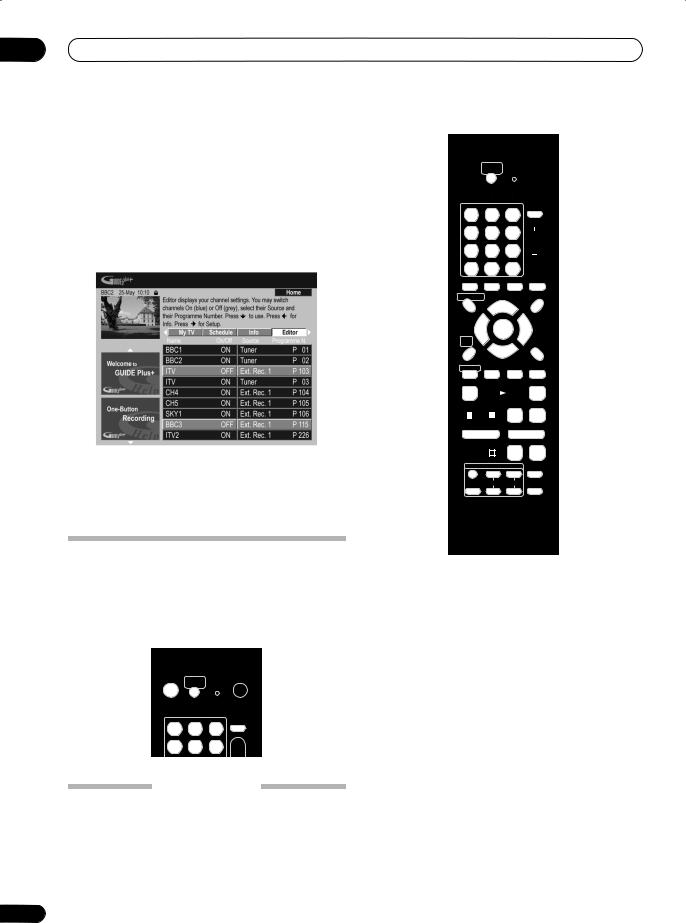
04 Getting started
on which the channel can be found on its receiving device/source. The entry in the Editor screen must match this number for correct recording of that channel.
•The above is especially important for the ‘host channel’. Please make sure that the host channel is always switched ON.
2 Use the number buttons to change the program numbers as you like.
3 When you’re done, press the BLUE Action button (Home) to get back to the GUIDE Plus+ home screen.
•You can find detailed information on using the GUIDE Plus+ system in the following chapter.
STANDBY/ON |
OPEN/CLOSE |
HDD DVD
CH
PLAY
PAUSE STOP
REC STOPREC
Selecting the hard disk or DVD for playback and recording
The HDD and DVD buttons (remote control and front panel) are used to select the hard disk (HDD) or DVD for playback and recording. The indicator in the front panel display shows which is currently selected.
HDD DVD
Making your first recording
This quick guide shows you how to make a basic recording of a TV program on either the HDD, or to a recordable DVD.
Recording is covered in much more detail in chapter 6 (Recording).
30
DVD RECORDER
1If they aren’t already on, switch on your TV and this recorder.
Press STANDBY/ON to switch on.
•Make sure that the video input on your TV is set to this recorder.
2Press HDD to record to the HDD, or DVD to record to a recordable DVD.
If you choose to record to the HDD, skip to step 5 now.
3 Press OPEN/CLOSE to open the disc tray.
4Load a blank DVD-R or DVD-RW disc with the label side face-up, using the disc guide to align the disc.
•When you load a new, blank DVD-RW disc, the recorder will take a moment to initialize it for recording.
•Blank DVD-R discs are ready for Video mode recording out of the box.
5Use the CH +/– buttons to select the TV channel you want to record from.
•You can also use the +/– buttons on the front panel if the recorder is stopped.
•Channel presets are numbered 1–99.
En
